Have you been looking for ManageEngine alternatives to manage your ITSM better?
ManageEngine provides a broad, cost-effective IT management suite with automated discovery, license reconciliation and procurement lifecycle features.
However, some customers of the software have not been happy with its complex implementation process, expensive pricing structure, and customer support.
In this article, I’ll go over the 10 best ManageEngine alternatives for ITSM in 2025 that can help you better manage your IT service management workflows.
TL;DR
- SmartSuite offers the best ManageEngine alternative with its no-code setup, ready-to-use ITSM templates, and customizable dashboards that help IT teams streamline processes in days, not months.
- Enterprise-grade tools like SolarWinds and ServiceNow are ideal for large organizations that need deep automation, network monitoring, or end-to-end service delivery.
- On the other hand, platforms like Atera and NinjaOne can help smaller IT teams or MSPs with affordable RMM, patch management, and lightweight ticketing in a single workspace.
But first, I wanted to cover the reasons why some IT managers have been looking to make the switch from ManageEngine: ⤵️
Why are some IT leaders looking to switch from ManageEngine?
The reasons why some IT managers have been looking to switch from ManageEngine are due to the tool’s tricky and complex implementation process, per-technician pricing model that can get expensive, and the customer support that leaves some of their questions hanging for too long.
But don’t get us wrong here, we’re not trying to claim that ManageEngine is a poor ITSM solution that needs to be switched from.
There are hundreds of satisfied users from around the world who will tell you otherwise.
After all, the tool comes with workflow rules, smart ticket routing, and built-in AI that help you streamline and accelerate resolution.
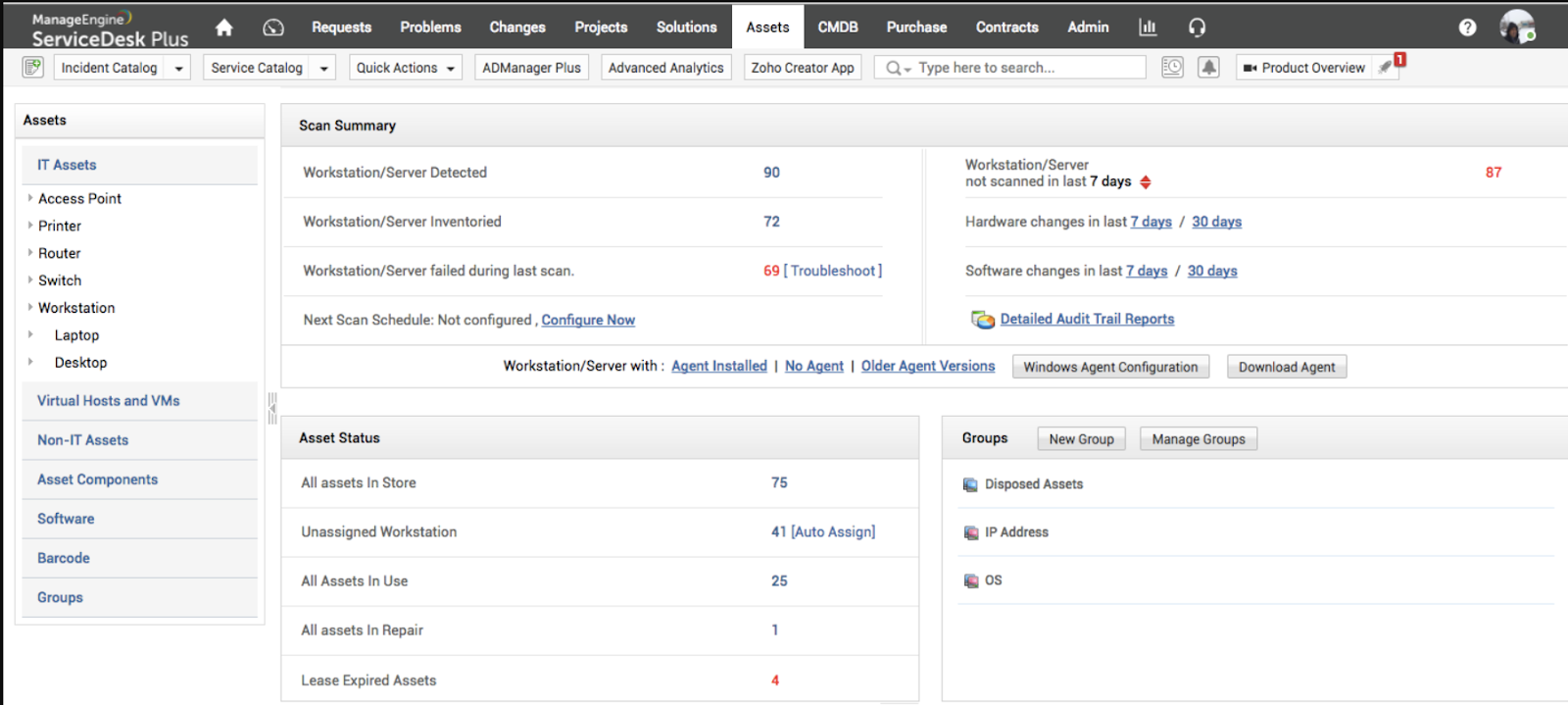
However, some users have been dissatisfied with the ITSM tool for several reasons:
#1: The initial implementation can be tricky and complex
The #1 complaint of ManageEngine’s users has been around the tool’s implementation.
Customers of the platform mention on G2 how tricky and complex it can be to get up and running with the software, and how it requires patience.
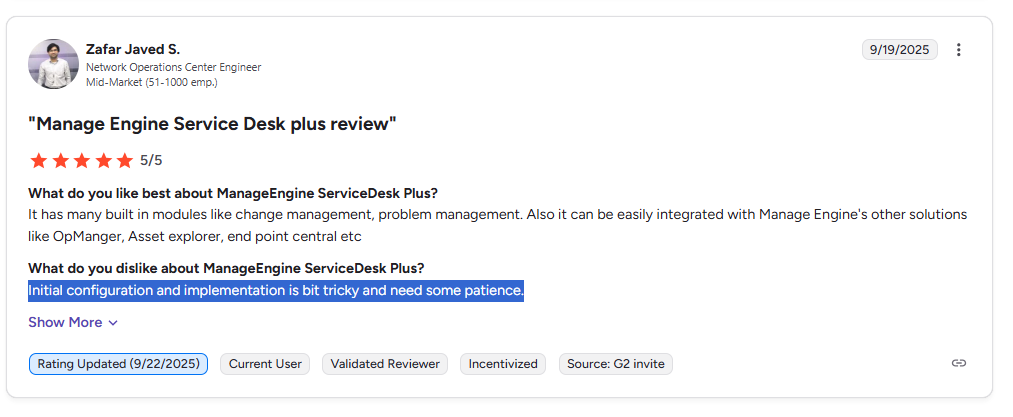
‘’Initial configuration and implementation is a bit tricky and needs some patience.’’ – G2 Review.
#2: Expensive pricing structure
Even though ManageEngine’s pricing starts from $13/month/technician, that is just for the basic IT help desk.
Users who want to combine the IT help desk with asset, change, and project management have to pay upwards of $67/month/technician to get the most out of the platform.
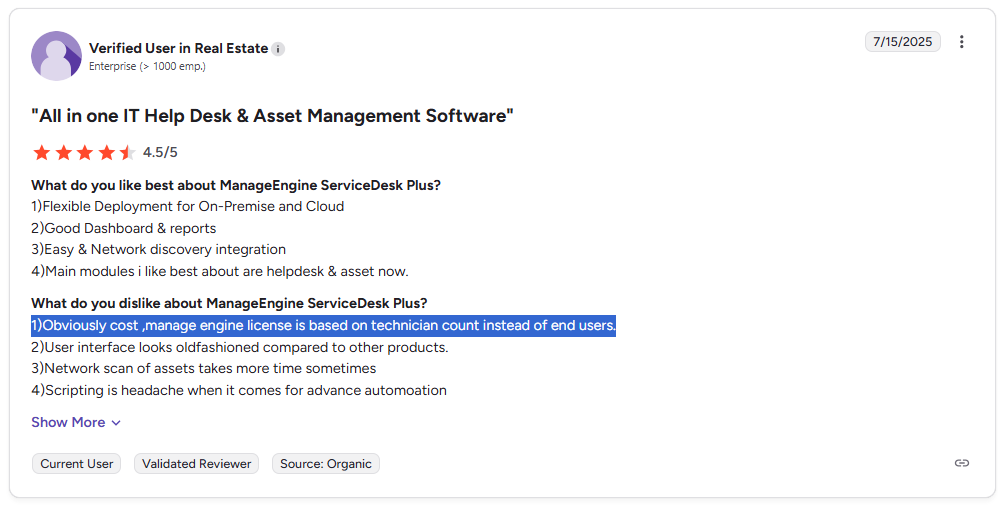
‘’Obviously, cost, ManageEngine license is based on technician count instead of end users.’’ – G2 Review.
#3: Customer support could be better
Last but not least, some customers of the software are not happy with the tool’s customer support.
One G2 review remembers their experience with ManageEngine’s customer support as ‘’hitting a brick wall’’ when trying to resolve their issues and mentions how dissatisfied they are with the lack of responsiveness on the solution’s side.
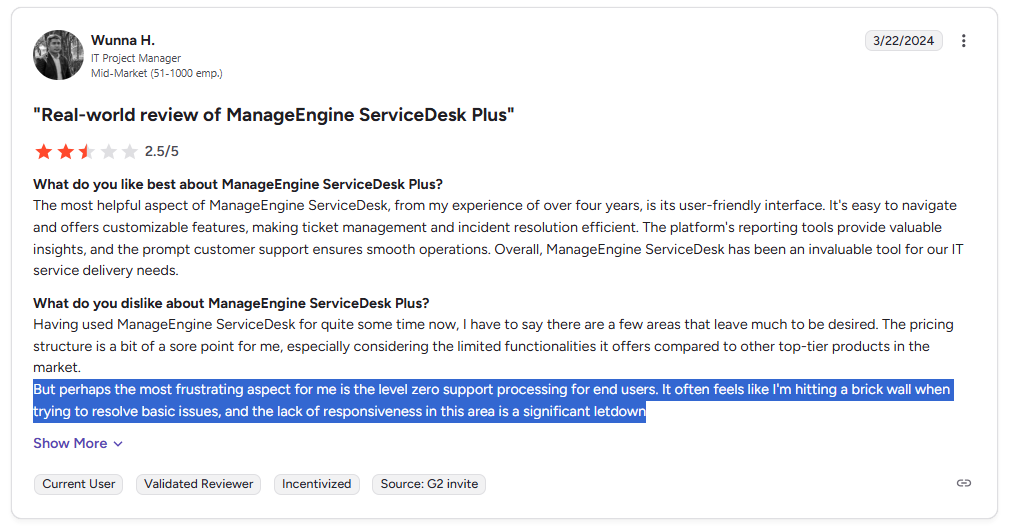
‘’But perhaps the most frustrating aspect for me is the level zero support processing for end users. It often feels like I'm hitting a brick wall when trying to resolve basic issues, and the lack of responsiveness in this area is a significant letdown.’’ – G2 Review.
What are the best alternatives to ManageEngine for ITSM in 2025?
The best alternatives to ManageEngine are SmartSuite, with its all-in-one customizable ITSM solution that can be set up in days, SolarWinds, and ServiceNow.
Here’s a breakdown of our shortlist of the top 10 ManageEngine alternatives on the market for IT service management after evaluating 30+ platforms:
#1: SmartSuite: Best for IT leaders looking to manage IT processes, projects, and assets in a customizable platform that can be set up in days, and not months.
#2: SolarWinds: Best for organizations that need enterprise-grade network and infrastructure monitoring tightly integrated with incident management.
#3: ServiceNow: Best for large enterprises that require full-lifecycle service management, heavy automation, and broad integrations.
#4: Atera: Best for MSPs and small IT departments seeking an affordable, single-pane-of-glass operations and billing tool.
#5: Ivanti: Best for organizations prioritizing endpoint security, patch automation and endpoint-to-service workflows.
#6: SysAid: Best for mid-sized organizations looking for an affordable, easy-to-manage ITSM tool with solid core features.
#7: NinjaOne: Best for small IT teams and MSPs that want an easy-to-use RMM with basic service desk capabilities.
#8: Freshservice: Best for mid-market IT teams looking for a fast-to-deploy, user-friendly ITSM with scalable automation and asset management capabilities.
#9: Startly: Best for small service teams that are looking for an inexpensive, unified ITSM and PSA stack with minimal integration overhead.
#10: Jira Service Management: Best for enterprises that need tight integration between IT service management and DevOps teams.
#1: SmartSuite
SmartSuite offers the best ManageEngine alternative in 2025, featuring our no-code, easy-to-use software that helps streamline critical IT processes, organise projects, and eliminate traditional obstacles in the tech landscape.
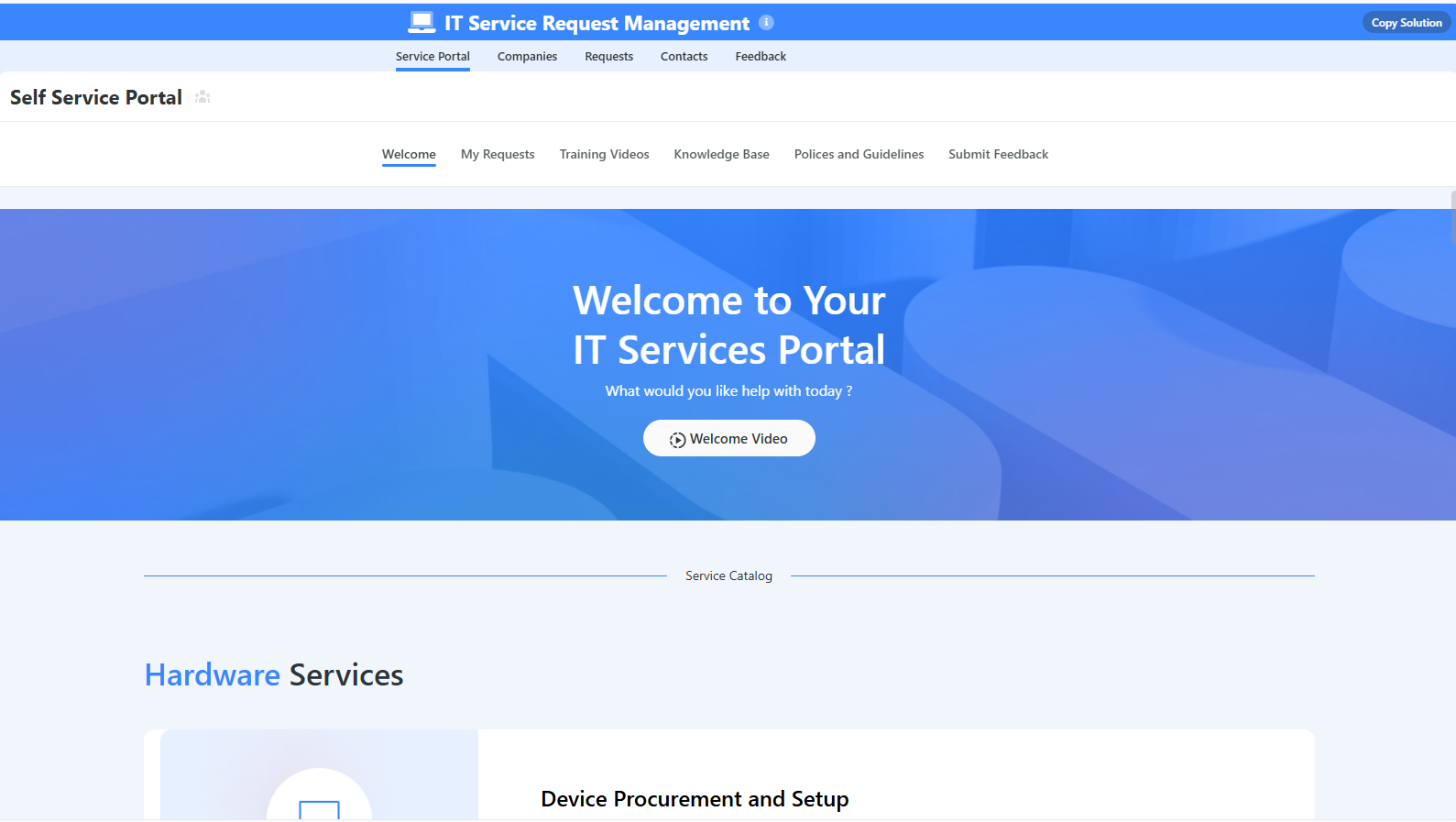
Here’s a quick walkthrough of the tool and our solution for IT leaders:
Let’s go over the features that make SmartSuite the best choice for small and large IT teams looking for a ManageEngine alternative: 👇
All-In-One IT Service Management
SmartSuite helps IT teams manage their IT processes, projects, and assets in a single, unified solution.
Our no-code, easy-to-use solution lets you automate all technical processes with ease.

Here are the capabilities and use cases that your team will get with SmartSuite:
- Manage critical IT processes: Manage IT data and workflows in one place, from deploying help desk and issue management solutions to ensuring core business operations stay uninterrupted.

- Track tickets & issues: You’ll be able to deploy a help desk and issue management solutions to ensure your business operations are not interrupted.

- Manage your IT assets and licenses: Track all of your IT assets, to whom they are deployed to and what software versions are deployed.

- Manage internal IT projects: You can plan deployments, schedule your teams, and monitor progress to ensure you deliver on time and under budget.

- Integrate with your existing systems: Your team can integrate with existing systems and data to consolidate and centralize your data.

- Automate for accuracy and efficiency: It’s possible to remove inefficiencies and the chance for human error by automating repeatable workflows.
- Monitor and report on your work with customizable IT dashboards: You can slice and dice data, track help tickets, work requests, and more in dynamic interactive dashboards.

Standardize Your Team’s IT Workflows
Your team can standardize your IT request workflow with a centralized work request process.
Our platform lets you prioritize tasks, assign IT staff and ensure that you achieve SLAs.

You’ll also be able to monitor your team with flexible reports and dashboards that keep you updated in real time.
Apart from that, SmartSuite's no-code automation builder provides IT teams with a visual interface that makes it easy to respond to events and take action.
That means you can customize your ITSM workflows without technical resources.
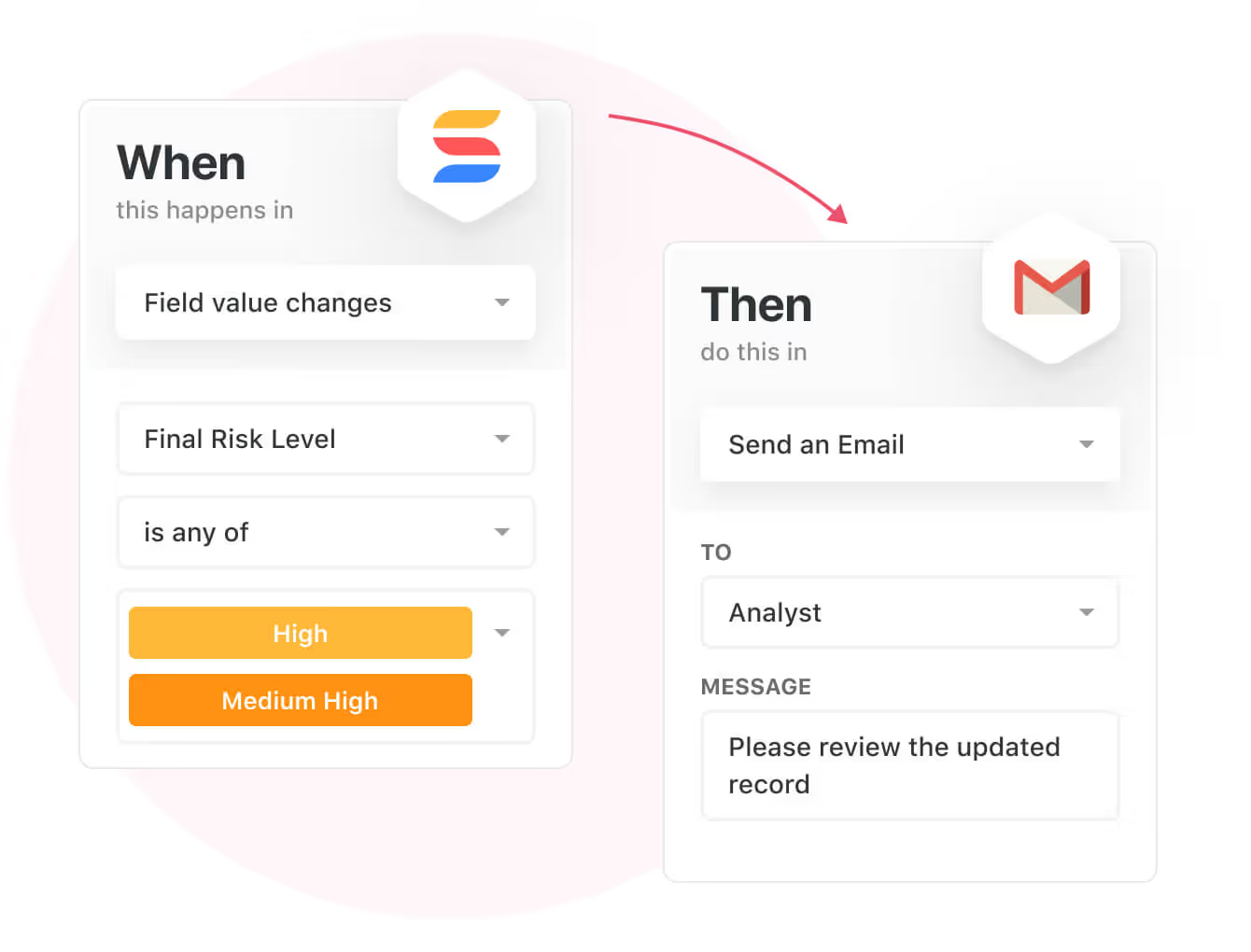
💡 Are you working from mobile? Stay connected to critical IT information, tickets and device information with our native iOS and Android apps.
Your team can use our mobile apps to share files, images, updates and other feedback to resolve problems and close tickets.

Ready-To-Use ITSM Templates
We have prepared a few ITSM templates for IT teams looking to get started right away, instead of building everything from scratch, such as an IT Help Desk.
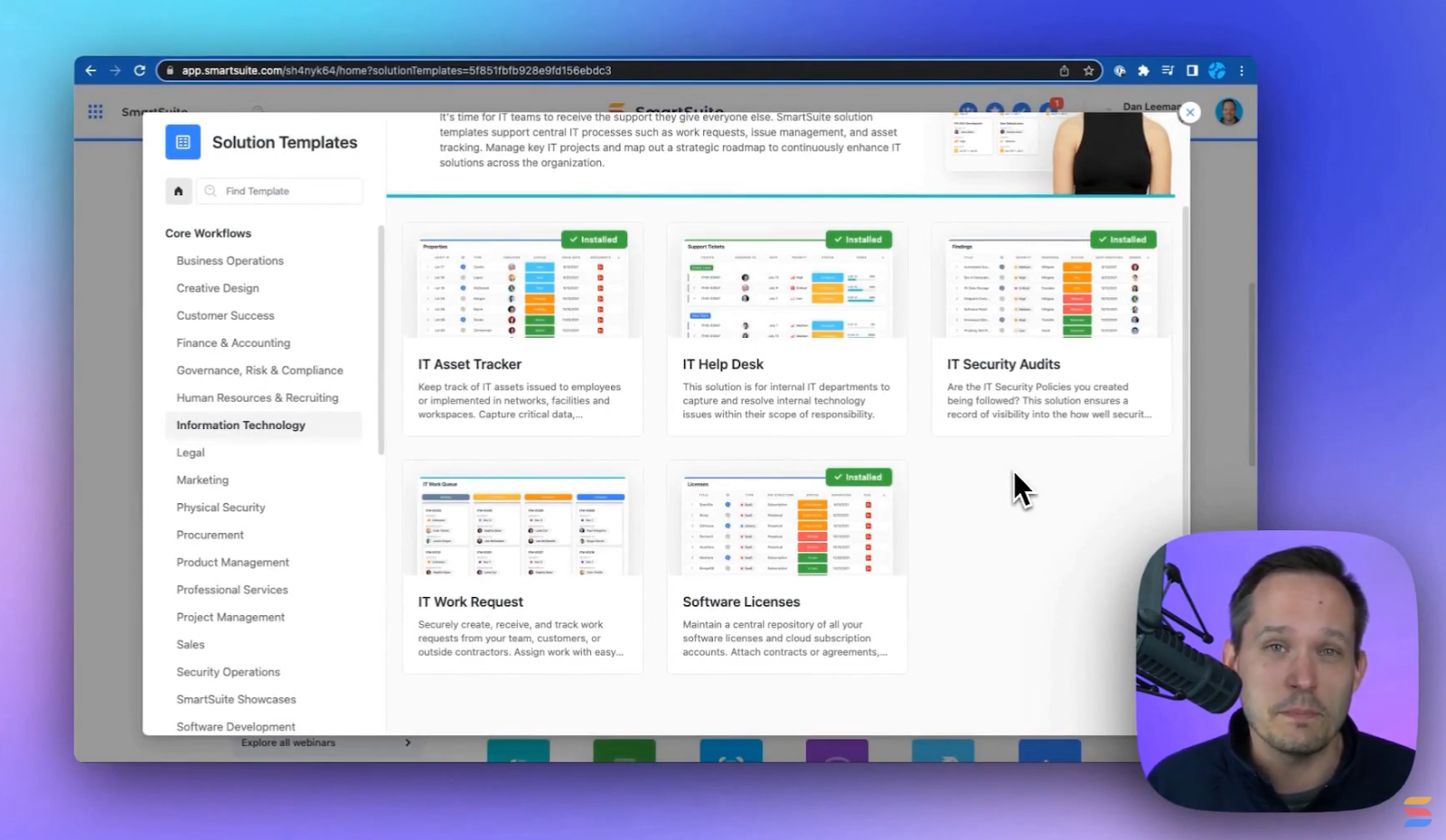
Our ITSM template includes:
- IT Service Request Management, where you can streamline work requests, automate repetitive tasks, and manage IT assets.
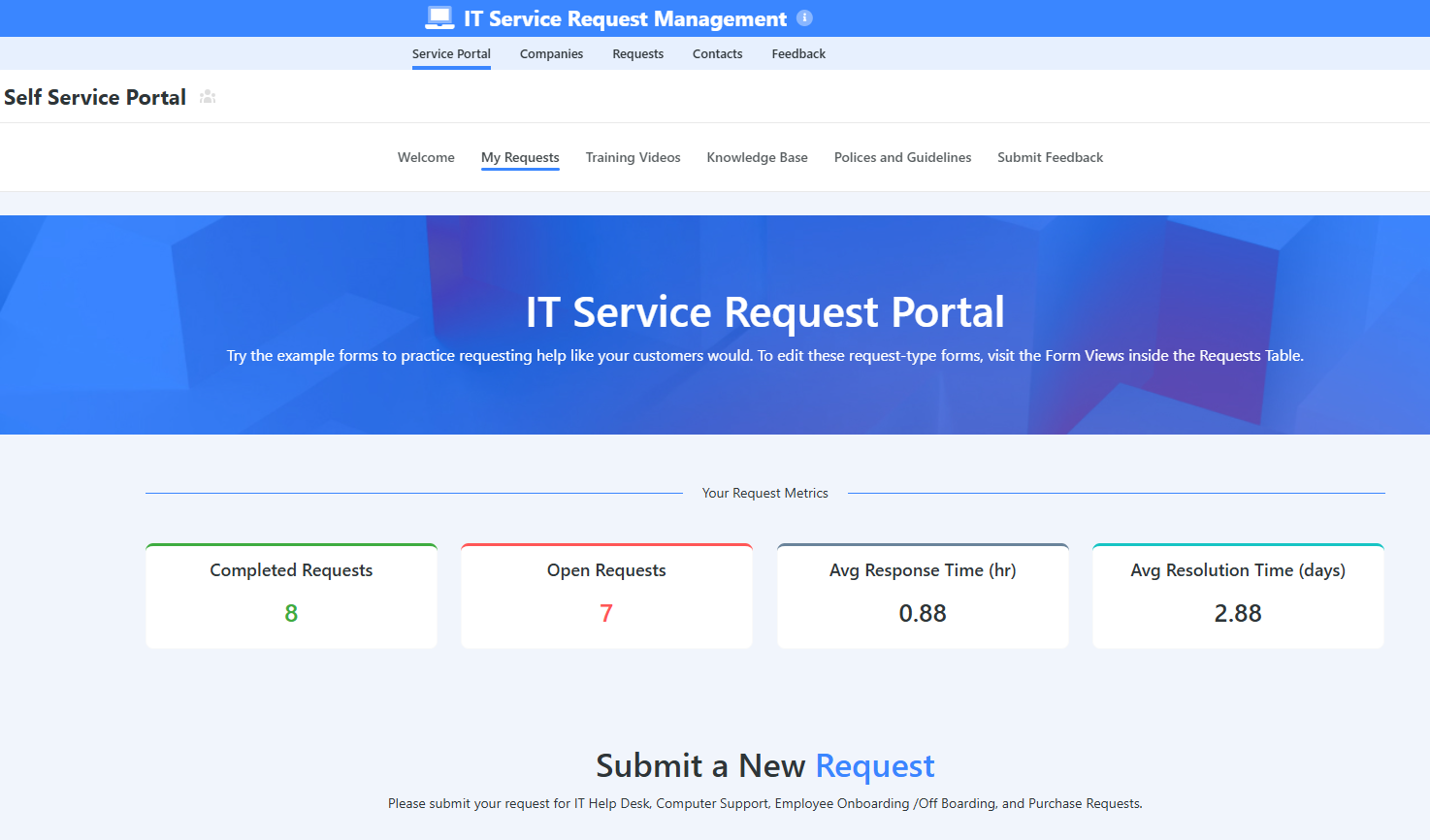
- IT Help Desk, which we built for internal IT departments looking to capture and resolve internal technology issues.
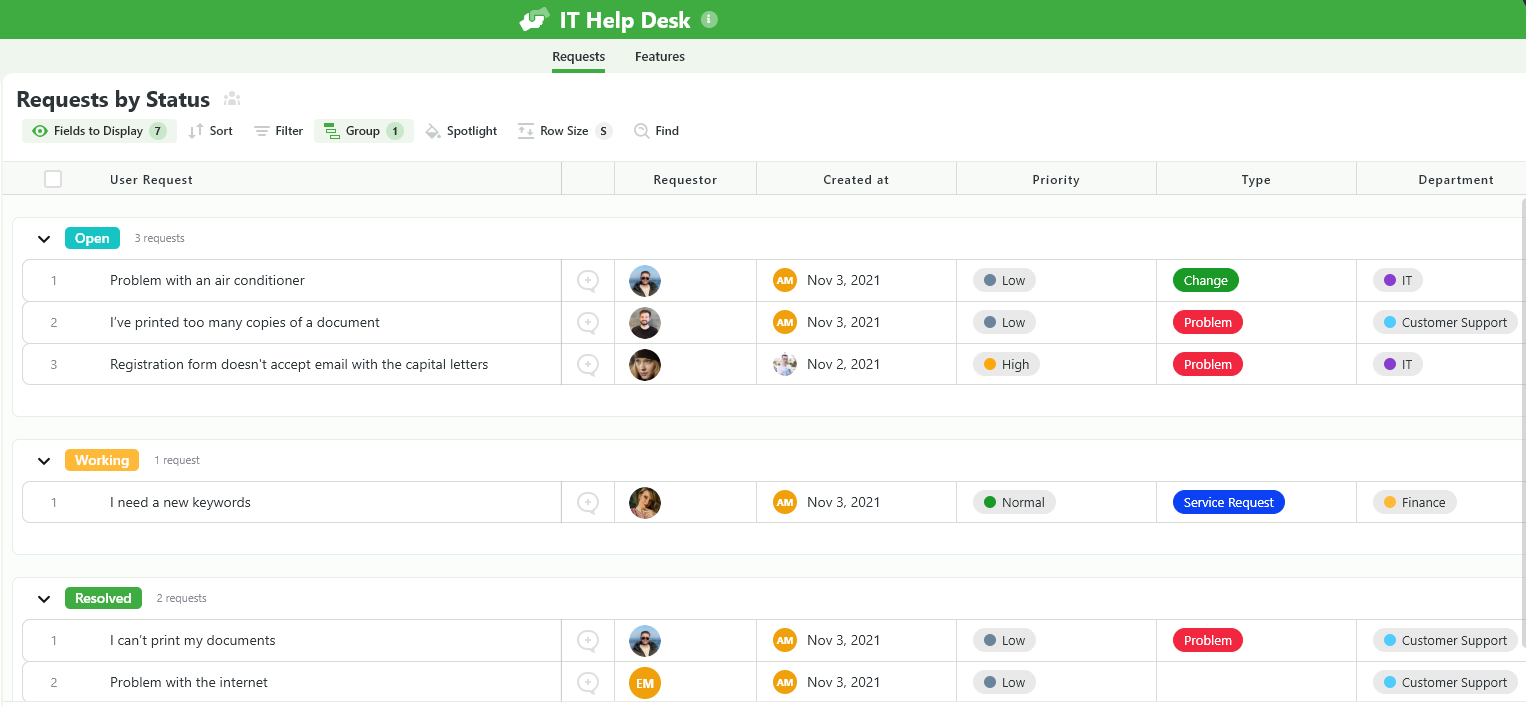
- IT Asset Tracker, where you can keep track of IT assets issued to employees or implemented in networks, facilities and workspaces.
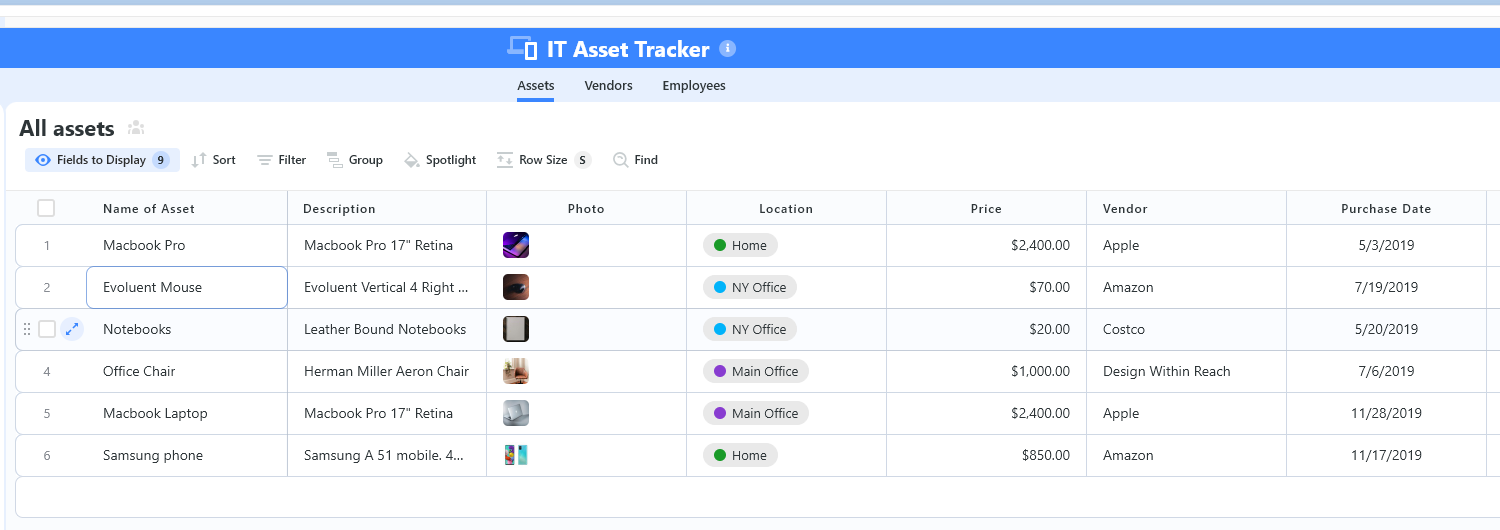
You can customize our ITSM management templates here for various use cases, such as IT Security Policies, IT Security Audits, and IT Work Requests.
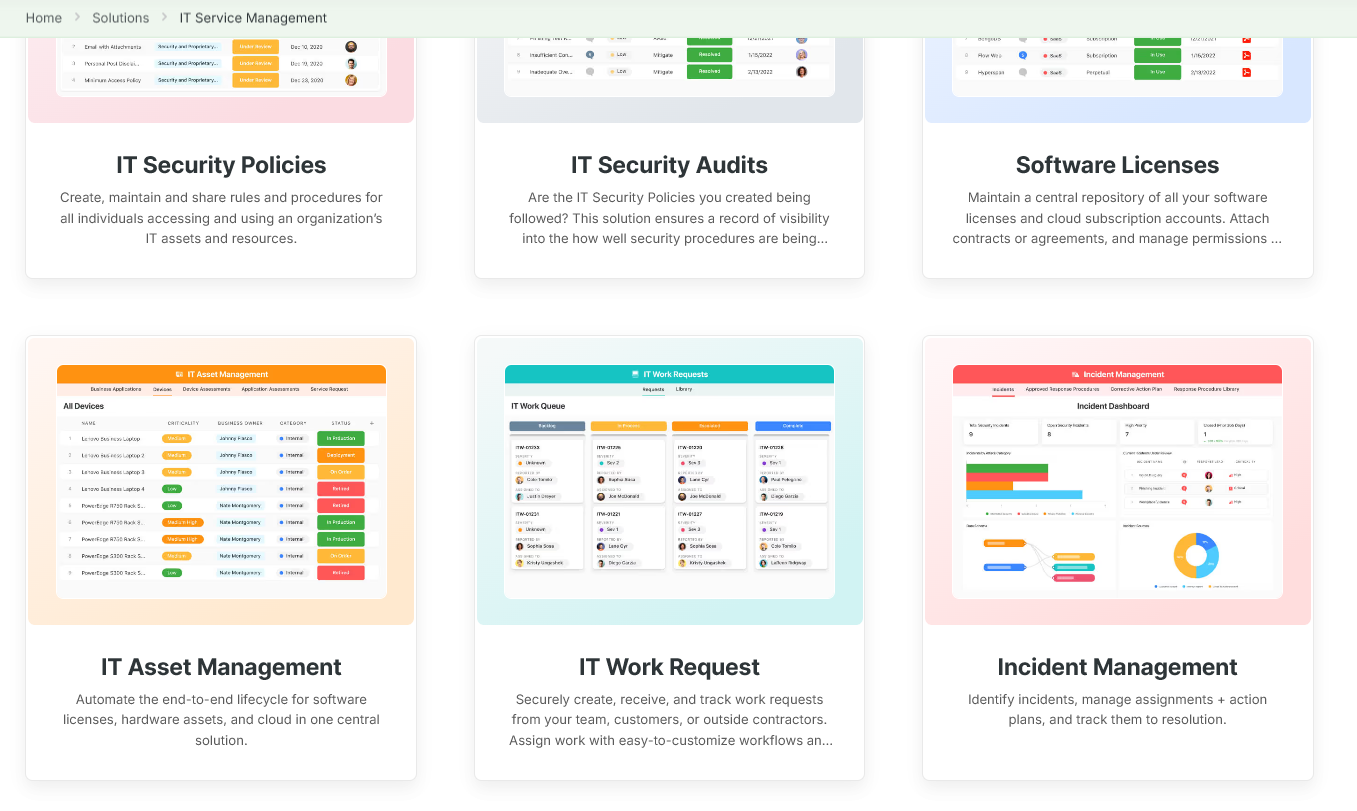
Pricing
Similar to ManageEngine, SmartSuite offers a free tier with access to 250+ automation actions, team collaboration, multi-dashboard views, and more.
There are four paid plans with a 14-day free trial (no CC required):
- Team: Starts at $12/user per month, including Gantt charts, timeline views, 5000 automation runs, and native time tracking.
- Professional: Starts at $30/user per month and adds two-factor authentication, Gmail & Outlook integrations, and unlimited editors.
- Enterprise: Starts at $45/user/month and includes access to audit logs, data loss prevention, and 50,000 monthly API calls.
- Signature: A customized plan tailored to your organization’s needs and team size with no predefined limits.
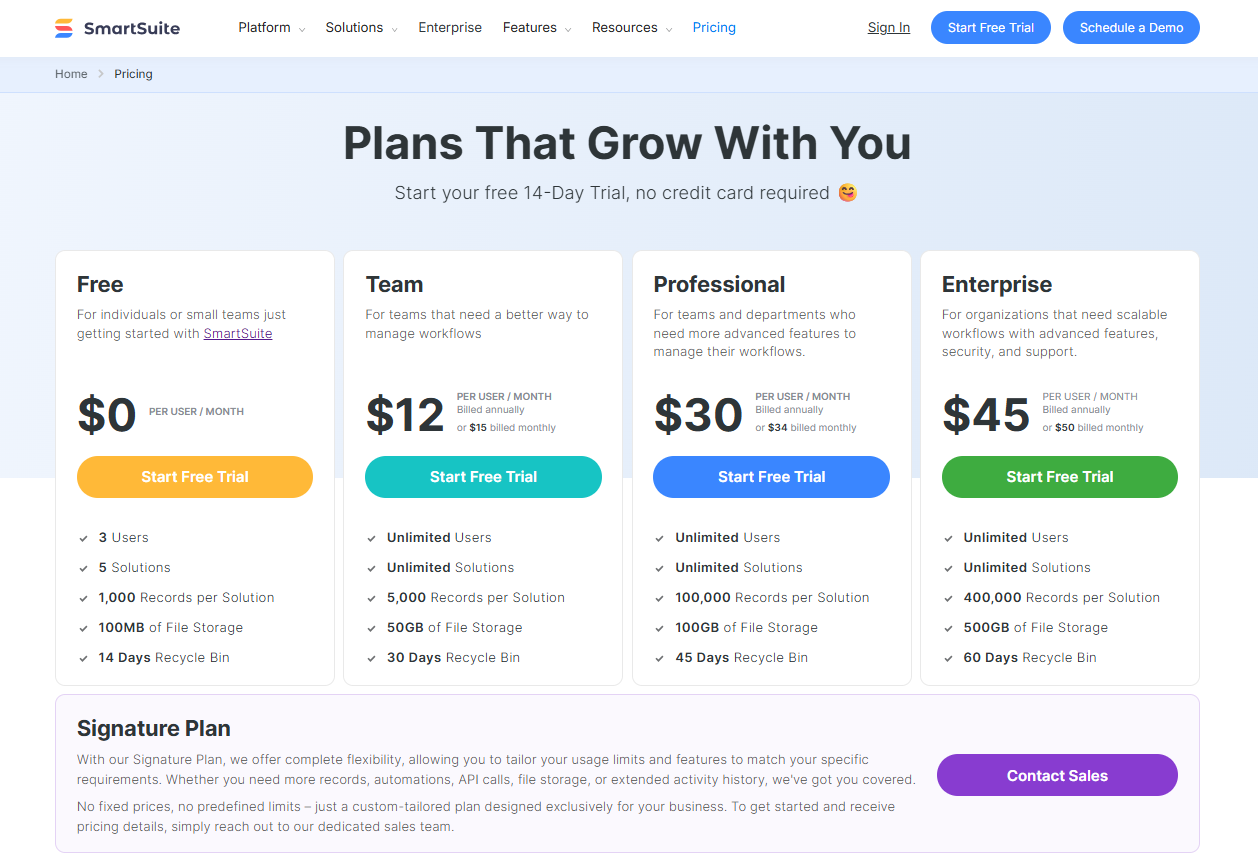
How does SmartSuite compare to ManageEngine?
Both SmartSuite and ManageEngine aim to give in-house IT teams a single place to manage tickets, assets, and everyday IT operations, but they take very different approaches.
ManageEngine is a mature ITSM suite with workflow rules, smart ticket routing, and built-in AI; however, many IT leaders move away from it because onboarding can be complex, the per-technician pricing can become expensive, and some customers report slow support.
SmartSuite, by contrast, is a simpler, no-code alternative that packs broad ITSM capability into a more transparent and flexible package.
Here’s how they stack up in the areas that matter most to IT teams:
Implementation & onboarding
- ManageEngine: Powerful but can be tricky to configure. Customers frequently note a steep initial learning curve and a setup that requires patience.
- SmartSuite: No-code, visual builders and ready-to-use ITSM templates (Help Desk, IT Service Request, Asset Tracker) make it fast to launch without heavy technical resources.
Pricing & licensing
- ManageEngine: Uses a per-technician licensing model that can look inexpensive at the entry level (from ~$13/technician/month for basic help desk) but rises quickly when you add modules (asset, change, project management). Customers report combined costs near $67/technician/month for fuller functionality.
- SmartSuite: Free tier + clear per-user plans (Team from $12/user/month; Professional, Enterprise, Signature tiers) and visible automation quotas. That makes cost forecasting easier and avoids the “pay for each module or technician” surprise.
Feature breadth & ready-made templates
- ManageEngine: Very feature-rich across classic ITSM domains, including asset management, change management, project management, and dynamic customizable templates.
- SmartSuite: Covers core ITSM (tickets, assets, projects) in a single workspace and ships with editable ITSM templates so small and large teams can get running immediately.
Automation & customization
- ManageEngine: Strong automation capabilities, including advanced workflow automations and AI-supported automations via AutomationEdge integrations.
- SmartSuite: No-code automation builder with visual rule creation so non-developers can automate workflows, reduce manual errors, and customize processes quickly.
Reporting & dashboards
- ManageEngine: Good baseline reporting, including instant reports and analytics
- SmartSuite: Highly customizable, interactive dashboards that let you slice SLA performance, ticket trends, and asset health in real-time.
Scaling & integrations
- ManageEngine: Mature integrations and deep ITSM features, but expanding functionality can mean higher licensing.
- SmartSuite: Integrations to consolidate existing systems and a pricing model that scales features within the plan (fewer add-on surprises). Enterprise plans include large API call volumes (e.g., 50k/month).
Support & user experience
- ManageEngine: Some users report slow or frustrating support experiences.
- SmartSuite: Easy to use and comes with template-driven onboarding to reduce the need for heavy support during implementation.
Pros & Cons
✅ A generous free plan that includes access to advanced features of the platform for up to 5 solutions.
✅ 9 ready-to-use ITSM templates that you can get started with right away.
✅ Dynamic dashboards and reporting that are easy to navigate.
✅ Integrated document and file management.
✅ Automate risk scoring, compliance tracking, audits, and vendor reviews.
✅ Modern and intuitive UI.
❌ Fewer native integrations when compared to other competitors on the market.
#2: SolarWinds
Best for: Organizations that need enterprise-grade network and infrastructure monitoring tightly integrated with incident management.
Similar to: Freshservice.
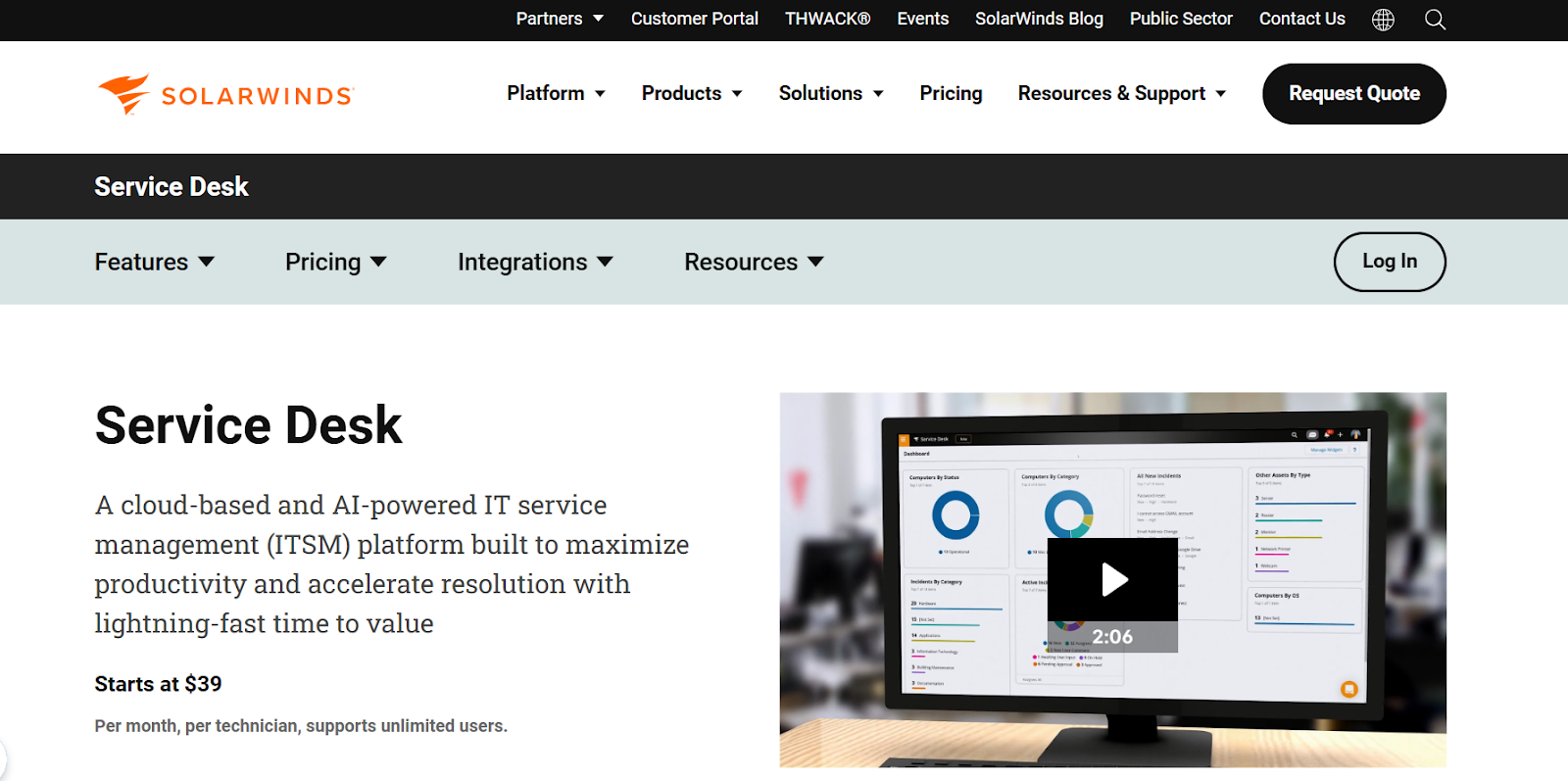
SolarWinds pairs deep, real-time monitoring with incident-to-ticket automation, making it a strong alternative to ManageEngine when ITSM needs tight coupling to network & systems telemetry.
The platform strength is operational visibility: you’ll be able to surface performance issues as service incidents so teams can remediate before users notice.
Features

- Automates ticket routing, prioritization, and reporting to help your team track and resolve IT incidents.
- Automated incident management is tightly connected to IT asset records, so tickets immediately reflect hardware and software context.
- Unified network performance monitoring and topology mapping that automatically surfaces degraded nodes and correlates them to service incidents.
Standout Feature: SolarWinds AI
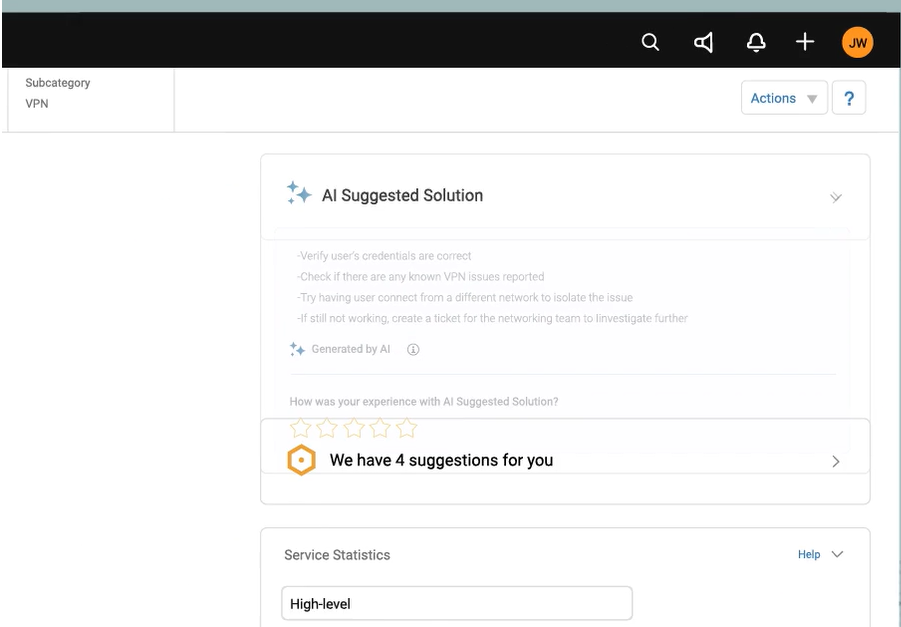
What stood out to me about SolarWinds is its AI capabilities that let you build support agents that can resolve or troubleshoot problems based on the initial request and comments within the ticket.
Pricing
SolarWinds Service Desk offers three pricing plans:
- Essentials: $39 per technician/month, includes incident management, knowledge base, service portal, asset management, and SLA management.
- Advanced: $79 per technician/month, adds custom fields, advanced automations, virtual agent, network discovery, and API access.
- Premier: $99 per technician/month, includes visual CMDB, advanced support, and up to 1,500 API calls per user per minute.

Pros and Cons
✅ Network and systems monitoring with mature alerting and correlation.
✅ Advanced automation capabilities.
✅ You can build an AI-powered agent to answer common questions.
❌ The platform’s navigation can sometimes be confusing.
❌ Can be complex to configure and costly for smaller IT teams, similar to ManageEngine.
#3: ServiceNow ITSM
Best for: Large enterprises that require full-lifecycle service management, heavy automation, and broad integrations.
Similar to: Jira Service Management.
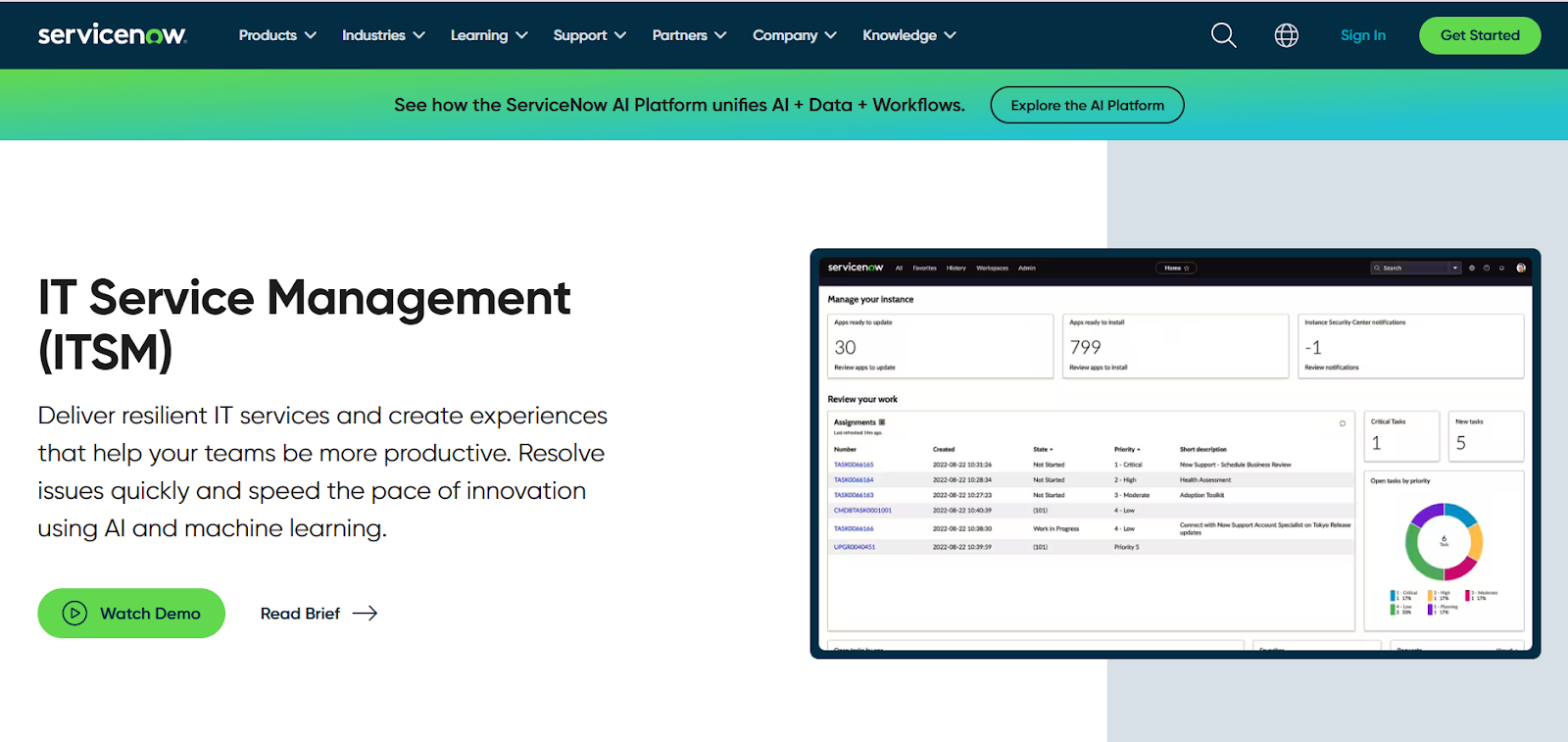
ServiceNow is built around ITSM, ITOM and workflow automation that can replace ManageEngine where enterprises need end-to-end service delivery, automation and a single authoritative CMDB.
The platform scales across IT, HR, security and customer workflows so service processes become highly automated and auditable.
Features

- A powerful low-code workflow engine and a single-source CMDB that support complex, cross-team orchestration.
- Now Assist for ITSM to help your team accelerate productivity with generative AI on the Now Platform.
- A management database that helps you track the dependencies and relationships of supported IT services to maintain continuity.
Standout Feature: Virtual Agent

ServiceNow’s ITSM solution comes with a Virtual Agent, which makes it easy for end users to resolve issues quickly from a conversational chatbot that has been trained with commonly asked questions and answers.
Pricing
ServiceNow’s pricing is not publicly disclosed, so you’d have to book a demo with their team.
I did find ServiceNow customer and public reviews, which show that the average cost of ServiceNow contracts can range between $50,000 and $500,000 annually.
The pricing structure depends on the number of licenses, features, and other configuration requirements.
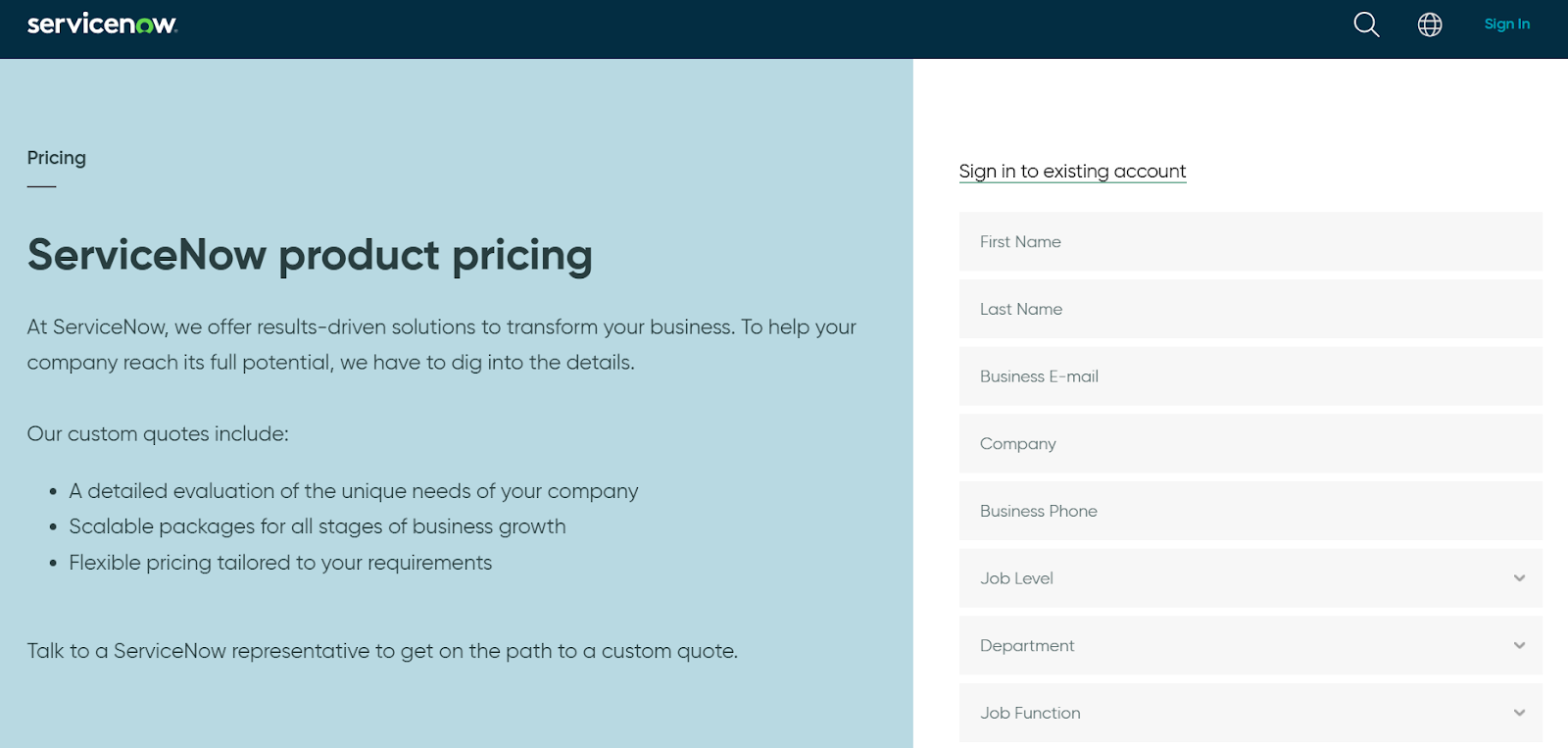
Pros & Cons
✅ Extremely configurable with rich automation and extensibility.
✅ Delight users with relevant, contextual, and conversational exchanges with a chatbot.
✅ Integrations with other platforms and centralized management of alerts and IT service management tickets.
❌ Steep learning curve and complexity, which is why some IT teams have been looking for ServiceNow alternatives.
❌ High licensing and implementation costs.
#4: Atera
Best for: MSPs and small IT departments seeking an affordable, single-pane-of-glass operations and billing tool.
Similar to: Freshservice.

Atera combines RMM, PSA and remote access into one lightweight, technician-centric platform, making it a ManageEngine alternative for MSPs and small IT teams.
The platform reduces tool-chain friction by putting monitoring, ticketing, patching and billing under one roof.
Features

- Single-agent RMM plus integrated PSA (ticketing, billing, and reports) so issues discovered by monitoring flow straight into managed service workflows.
- Automates software patching and updates for Windows, Mac, and various applications to keep systems secure and up-to-date.
- Atera’s integrated helpdesk and ticketing system can help you better manage support requests and incidents.
Standout Feature: Remote Monitoring and Management (RMM)

Atera’s RMM software offers full visibility and control over IT infrastructure to enable users to monitor and manage devices, servers, and networks proactively.
Pricing
Atera’s pricing offers four main pricing plans for IT departments:
- Professional: $149 per technician/month (billed annually), which includes remote monitoring, patch management, automations, helpdesk, and ticketing.
- Expert: $189 per technician/month (billed annually), which adds advanced security features, network discovery, and more customization options.
- Master: $219 per technician/month (billed annually), which adds audit logs with 1 year retention, custom support addresses, and reporting.
- Enterprise: Custom pricing, which adds onboarding, premium customer support, and enterprise-grade security with custom analytics.

Pros and cons
✅ Effective patch management and security scanning.
✅ Intuitive user interface and easy deployment.
✅ More cost-effective for smaller IT teams compared to SolarWinds’ enterprise-grade solution.
❌ Limited mobile app functionality, according to customers of the platform.
❌ More expensive than ManageEngine and other tools on the market, which is why some users have been looking for Atera alternatives.
#5: Ivanti
Best for: Organizations prioritizing endpoint security, patch automation and endpoint-to-service workflows.
Similar to: ServiceNow.
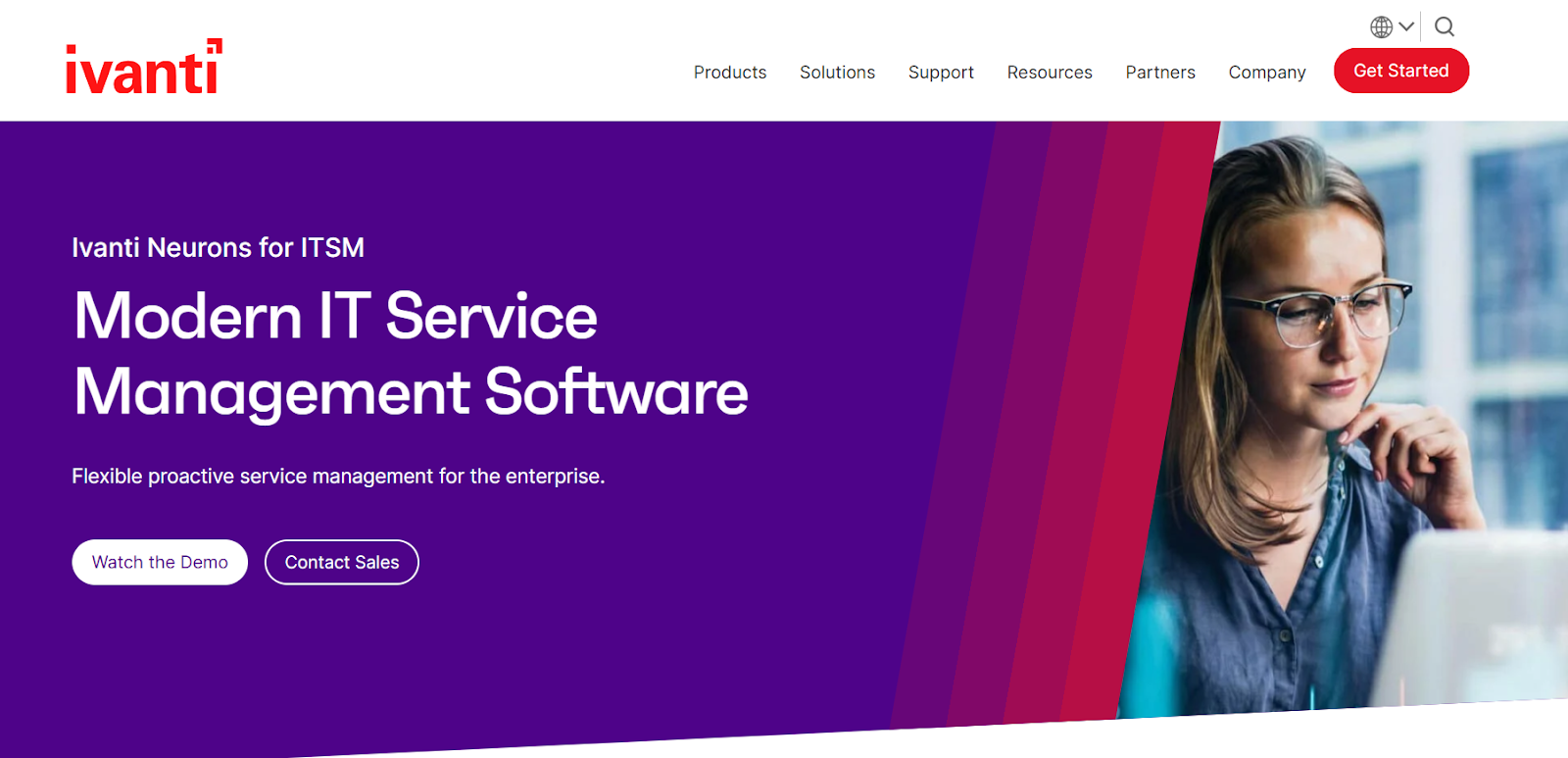
Ivanti is strong where endpoint lifecycle, patching and secure access are core ITSM concerns, as the platform pairs endpoint management, unified endpoint security and service desk capabilities to close the loop from detection to remediation.
The tool is a viable ManageEngine alternative when you want automated remediation tied directly to IT tickets and compliance workflows.
Features
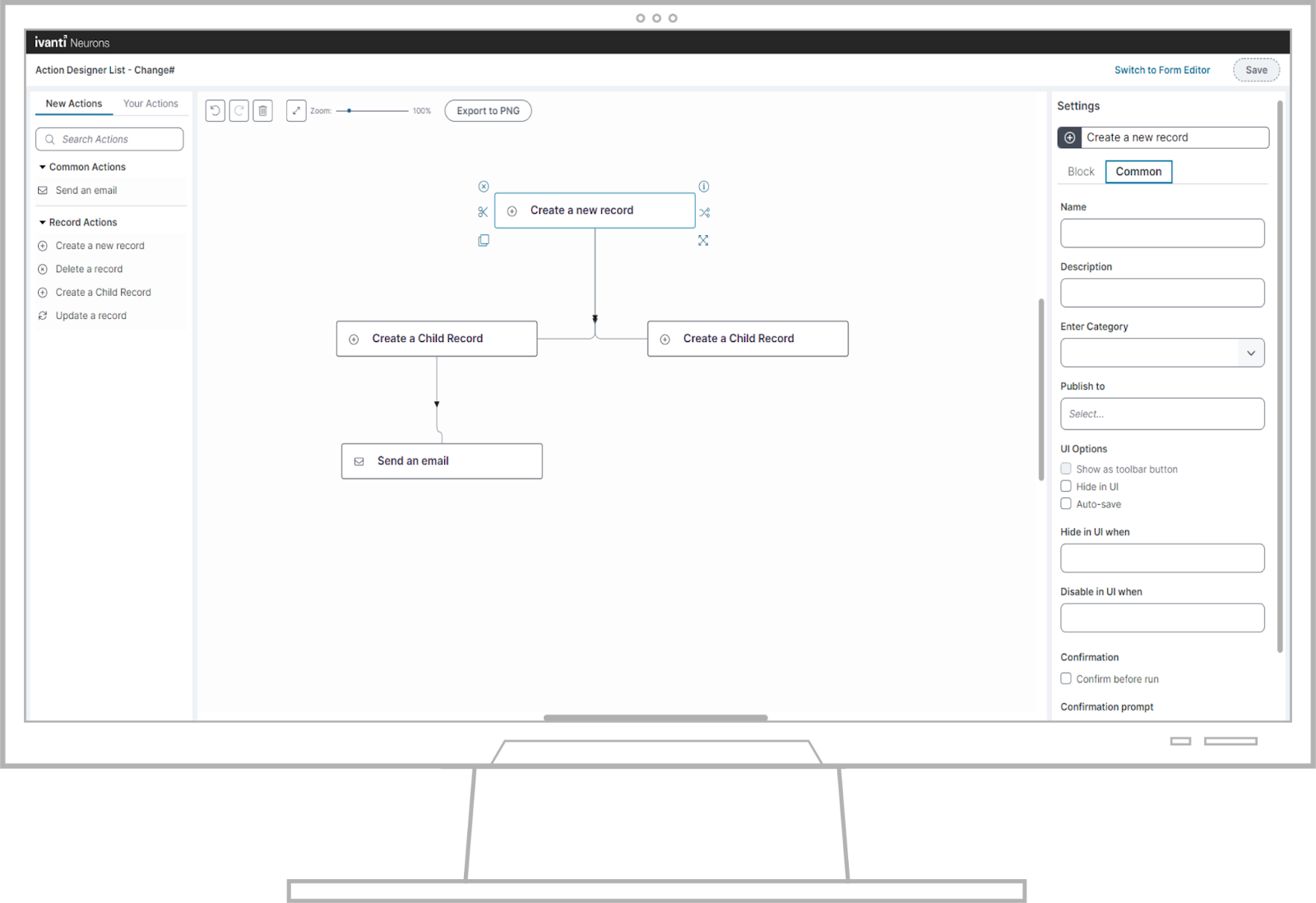
- Integrated endpoint management and vulnerability remediation that automatically creates and escalates tickets for remediation.
- It’s possible to deploy intelligent AI-powered chatbots and service portals that guide end users, surface knowledge articles, and resolve common issues.
- Monitor service delivery, quality, and SLA commitments with customizable, role-specific dashboards for executives, managers, and technicians.
Standout Feature: Modular, Maturity-Driven Scalability

Ivanti’s modular architecture lets you add advanced capabilities, such as shift-left automation and proactive AI remediation, to support your growth from foundational help-desk ticketing to comprehensive, predictive IT operations.
Pricing
Ivanti does not disclose its pricing, so you’d have to contact their team for a demo and a quote.
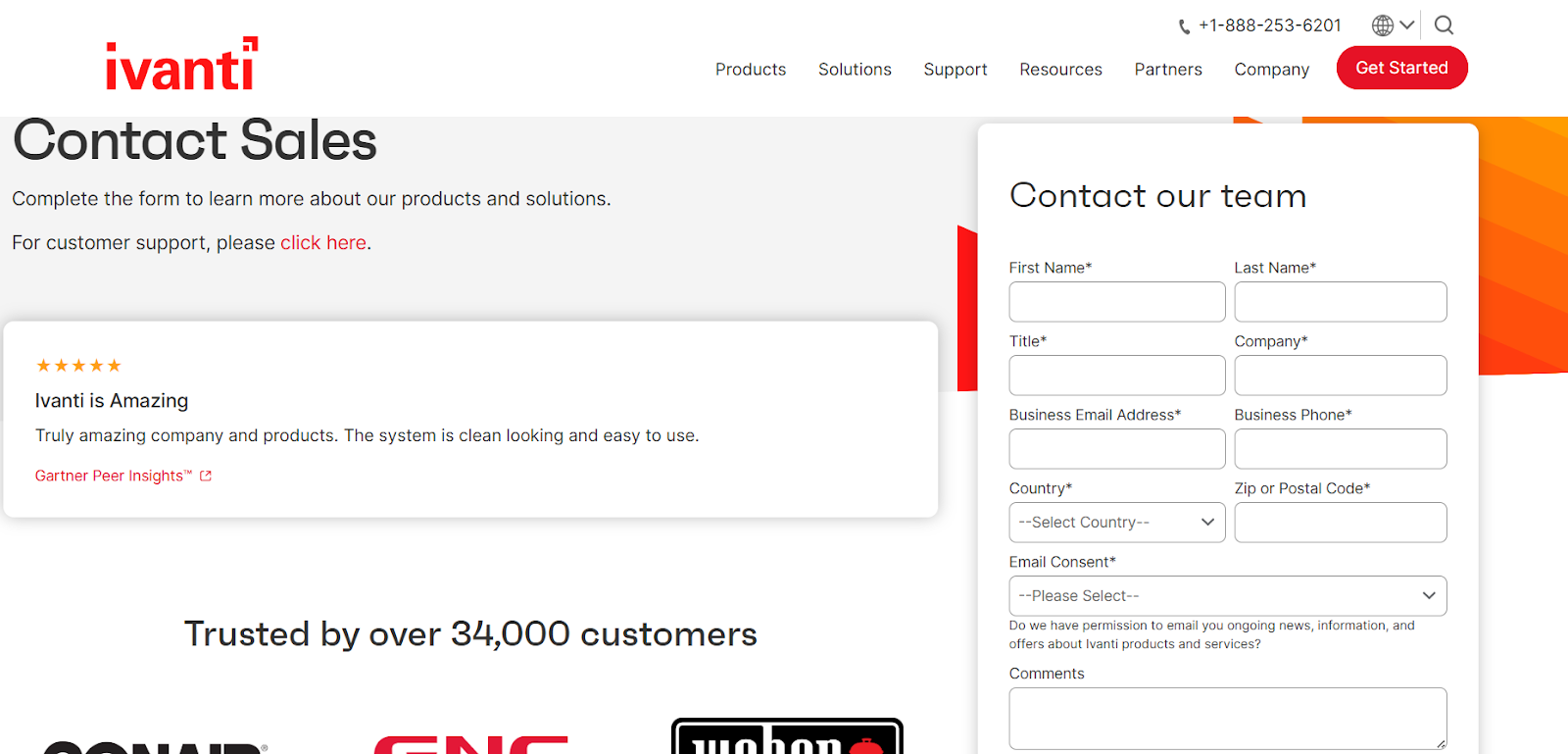
Pros & Cons
✅ Endpoint control and automated remediation capabilities.
✅ Drag-and-drop functionality that lets you start small.
✅ Good asset management features.
❌ Customer support can be slow to respond, which is why some brands have been looking for Ivanti alternatives.
❌ The platform can be complex to learn how to best use due to its comprehensive range of features.
#6: SysAid
Best for: Mid-sized organizations looking for an affordable, easy-to-manage ITSM tool with solid core features.
Similar to: Atera, SolarWinds Service Desk.
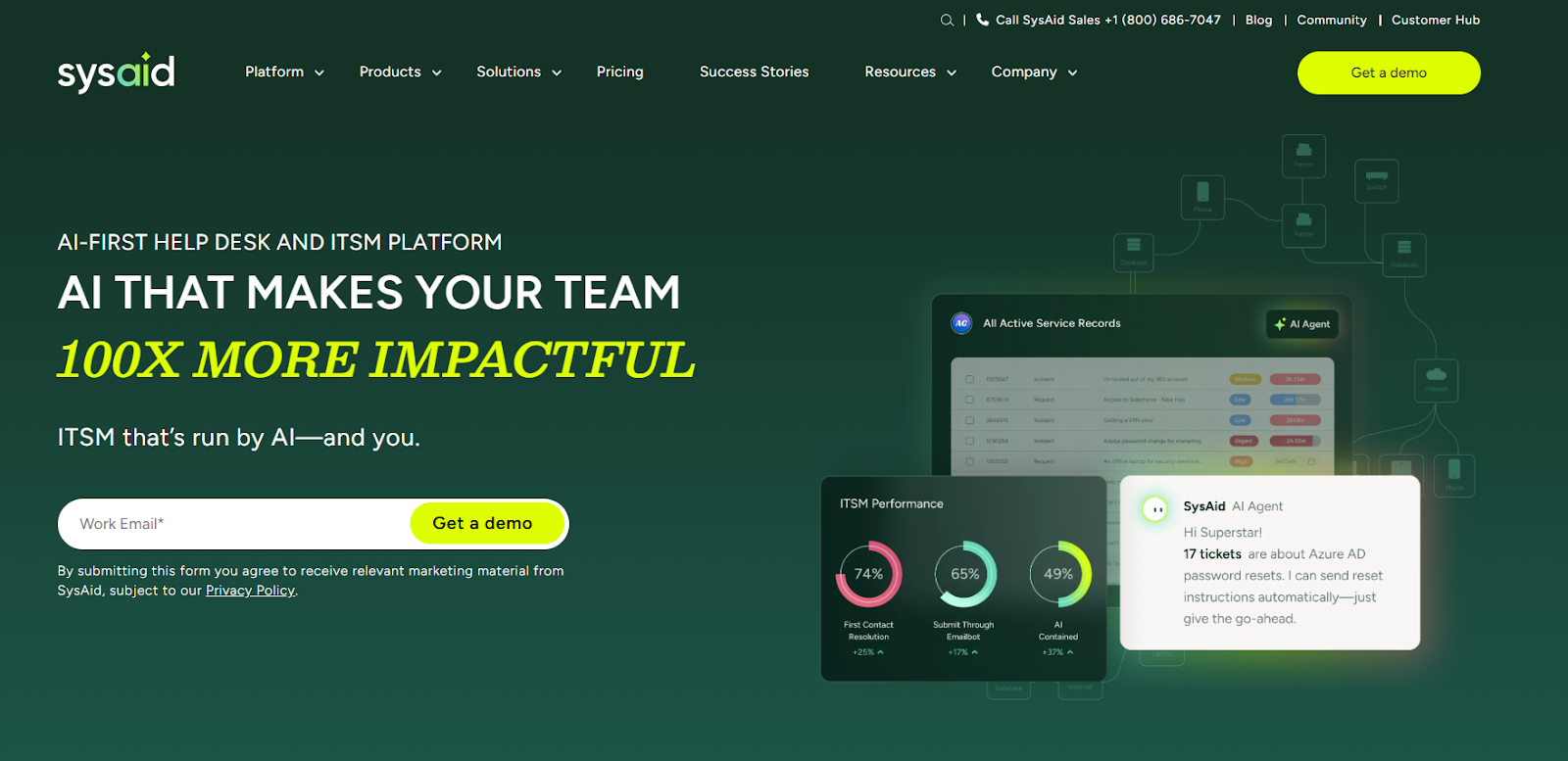
SysAid offers a traditional, configurable ITSM stack with options for cloud or on-premise deployment and strong automation and AI assistants to speed triage and resolution.
The platform offers a solid ManageEngine alternative for organizations that need a classic ITIL-capable tool without enterprise lock-in.
Features

- Built-in ITSM modules (service desk, assets, self-service portal) plus automation rules to triage and route tickets.
- Tracking and management of hardware, software, and other IT assets across the organization.
- AI agents and workflow automation that streamline routing, escalation and common remediation tasks.
Standout Feature: Agentic Service Management
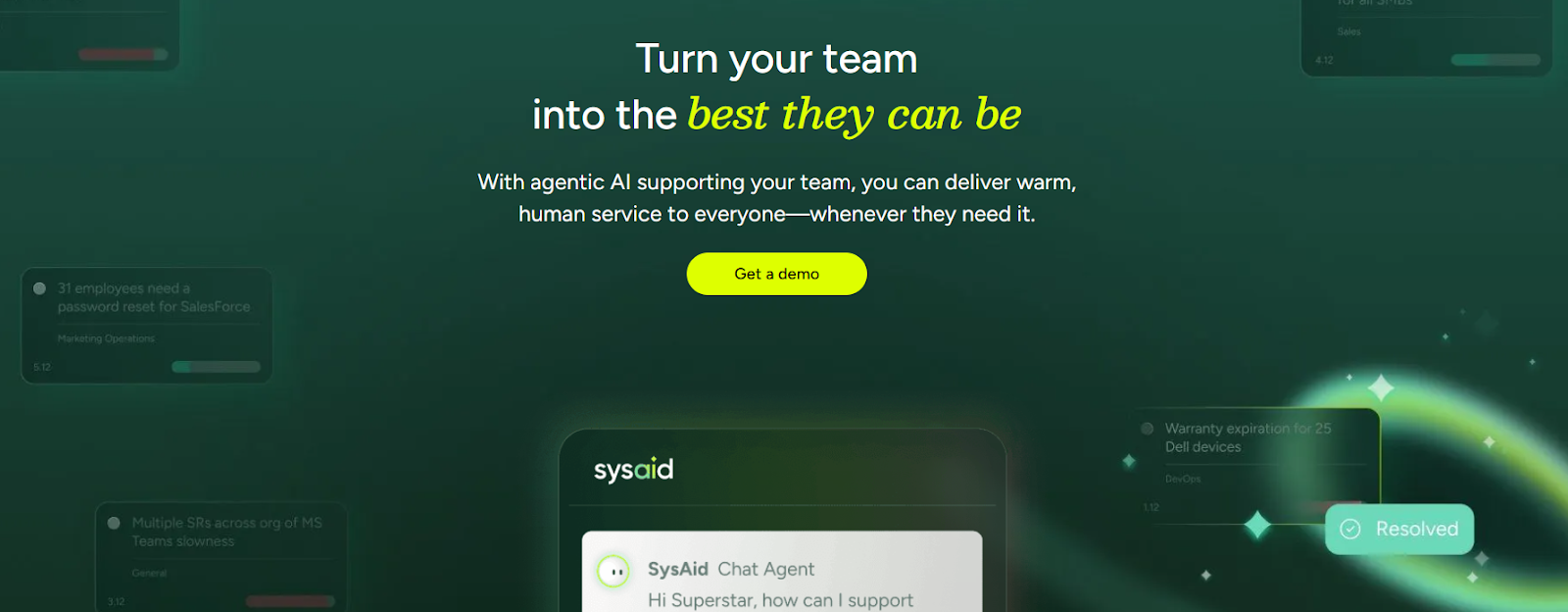
SysAid offers an agentic AI solution that lets you automatically detect and resolve issues.
The tool is also capable of routing, fulfilling, and tracking requests with service-level agreement awareness.
Pricing
SysAid offers three main pricing plans, but has not disclosed its pricing for them:
- Help Desk: Designed for lean teams, includes incident management, self-service portal, service catalog, asset management, and basic reporting.
- ITSM: For mid-sized organizations, it adds workflow automations, third-party integrations, and advanced SLA management.
- Enterprise: For large teams, includes all IT service management features with unlimited agents, automation rules, and custom columns.

Pros and Cons
✅ Advanced help desk functionality for managing incidents, requests, and problems.
✅ The tool lets you customize workflows and reports to meet your needs.
✅ Enterprise-grade ITSM solution.
❌ Fewer enterprise-scale integrations and advanced capabilities than larger platforms.
❌ A long implementation process, according to user reviews, similar to ManageEngine.
#7: NinjaOne
Best for: Small IT teams and MSPs that want an easy-to-use RMM with basic service desk capabilities.
Similar to: Startly.
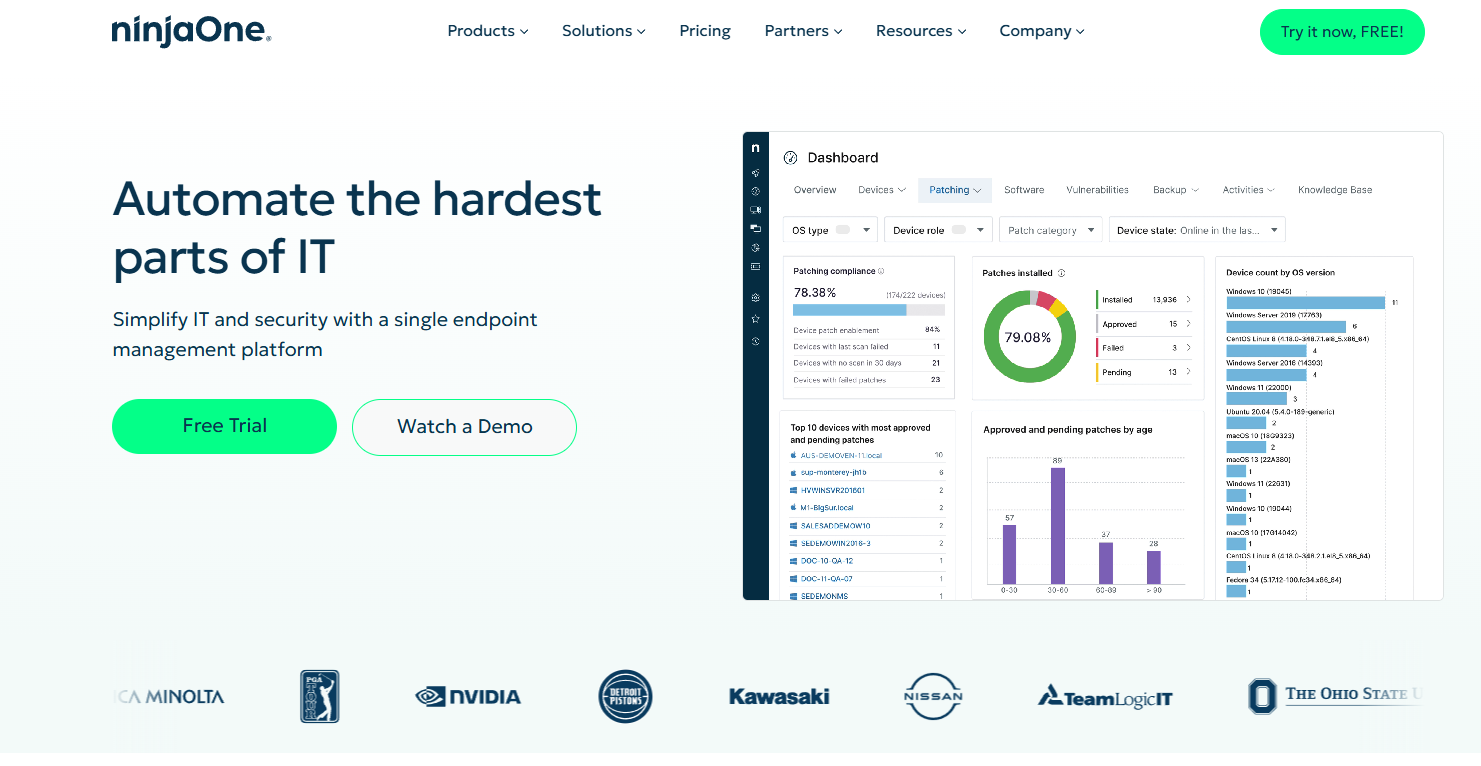
NinjaOne is a modern RMM platform that includes ticketing and endpoint management, making it a viable ManageEngine alternative when speed, simplicity and efficient remote management are the top priorities.
I think of the platform as especially useful when you want fast agent deployment, scripted remediation and lightweight ticketing in one place.
Features
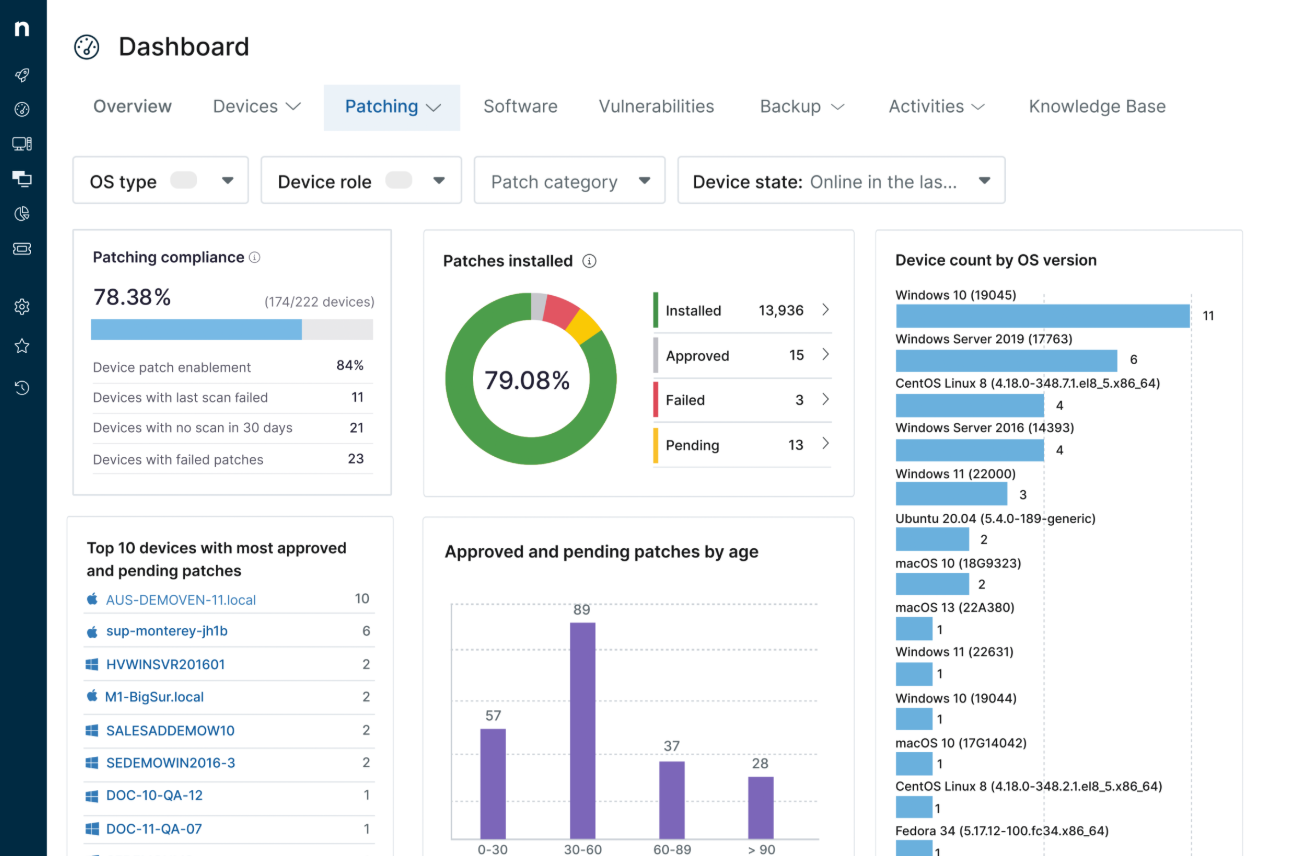
- Remote monitoring and alerting that provides real-time status of devices across Windows, macOS, and Linux, with smart notifications.
- Automated patch management that automatically deploys OS and third-party updates across endpoints to help you reduce manual maintenance and improve system security compliance.
- Integrated service desk that offers ticket logging, workflow automation, and remote support all within the same interface.
Standout Feature: ManageEngine’s Endpoint Management
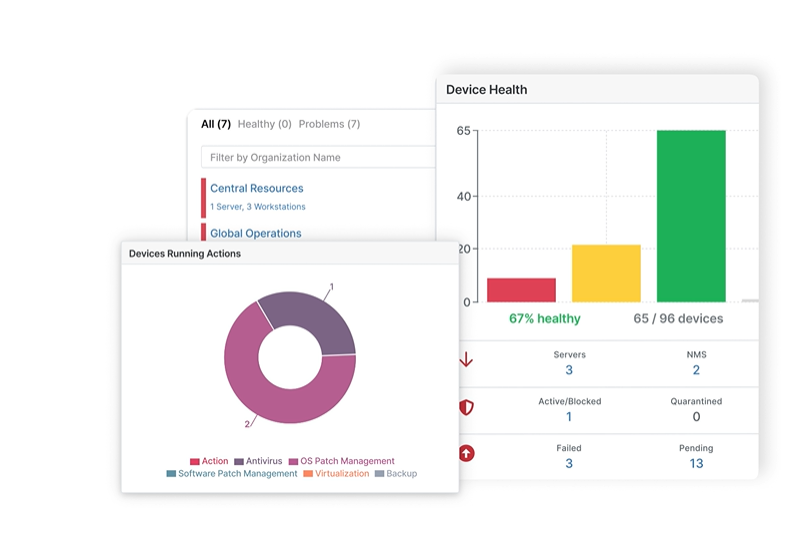
What stood out to me about ManageEngine is its endpoint management capabilities that help you:
- Unify visibility and control by managing all workflows, end-user devices, servers, VMs, and networking devices.
- Automate your IT operations, such as patching and configuration management.
- Solve issues faster with real-time monitoring, alerting, and actions.
Pricing
NinjaOne doesn’t publish subscription prices, as each price is custom-tailored to each team and their unique needs.
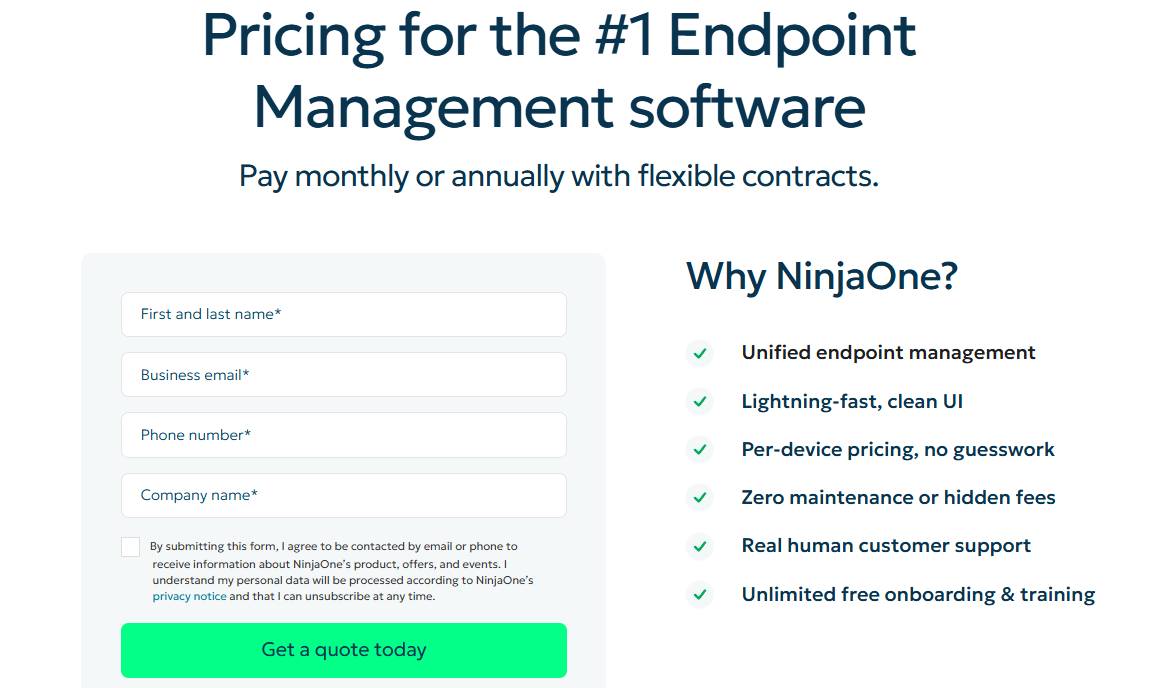
However, its website does state that NinjaOne follows a per‑device pricing model with monthly or annual contracts, with the pricing depending primarily on the number of endpoints you manage.
➡️ The platform’s pricing scales with volume, starting at around $3.75 USD per device/month for smaller environments and dropping to about $1.50 USD per device/month at very high volumes (10,000 endpoints or more).
Pros & Cons
✅ User-friendly interface with an intuitive dashboard that reduces training time and speeds adoption.
✅ Unified view of IT operations, with service desk, patching, asset inventory, and backup all accessible from a single console.
✅ Fast onboarding and strong remote management tools.
❌ Lacks deep reporting customization, as users often want more flexibility in dashboards and export formats.
❌ Not a full-featured ITSM suite. The tool relies on integrations for some advanced ITSM processes.
#8: Freshservice
Best for: Mid-market IT teams looking for a fast-to-deploy, user-friendly ITSM with scalable automation and asset management capabilities.
Similar to: Jira Service Management, Zendesk.

Freshservice offers a modern, easy-to-deploy ITSM platform that blends ITIL best practices with user-friendly service catalogues, automation and AI suggestions.
The tool is a viable ManageEngine alternative, as it’s been built to be used by non-technical admins while still offering advanced automation, discovery and asset management capabilities.
Features
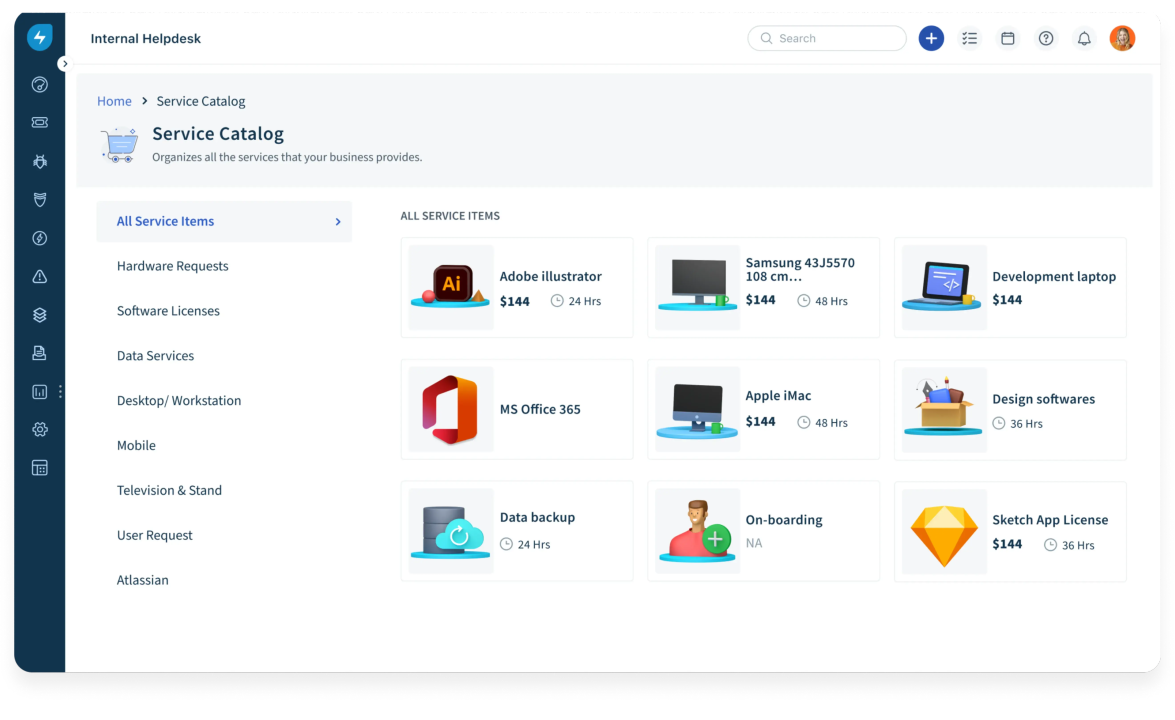
- AI-powered ticket routing and suggested resolutions combined with an intuitive service catalogue that reduces agent workload.
- Self-service portal that helps your team independently find solutions and submit requests.
- You’ll be able to monitor and manage your IT assets, including hardware and software.
Standout Feature: Best-In-Class Automations
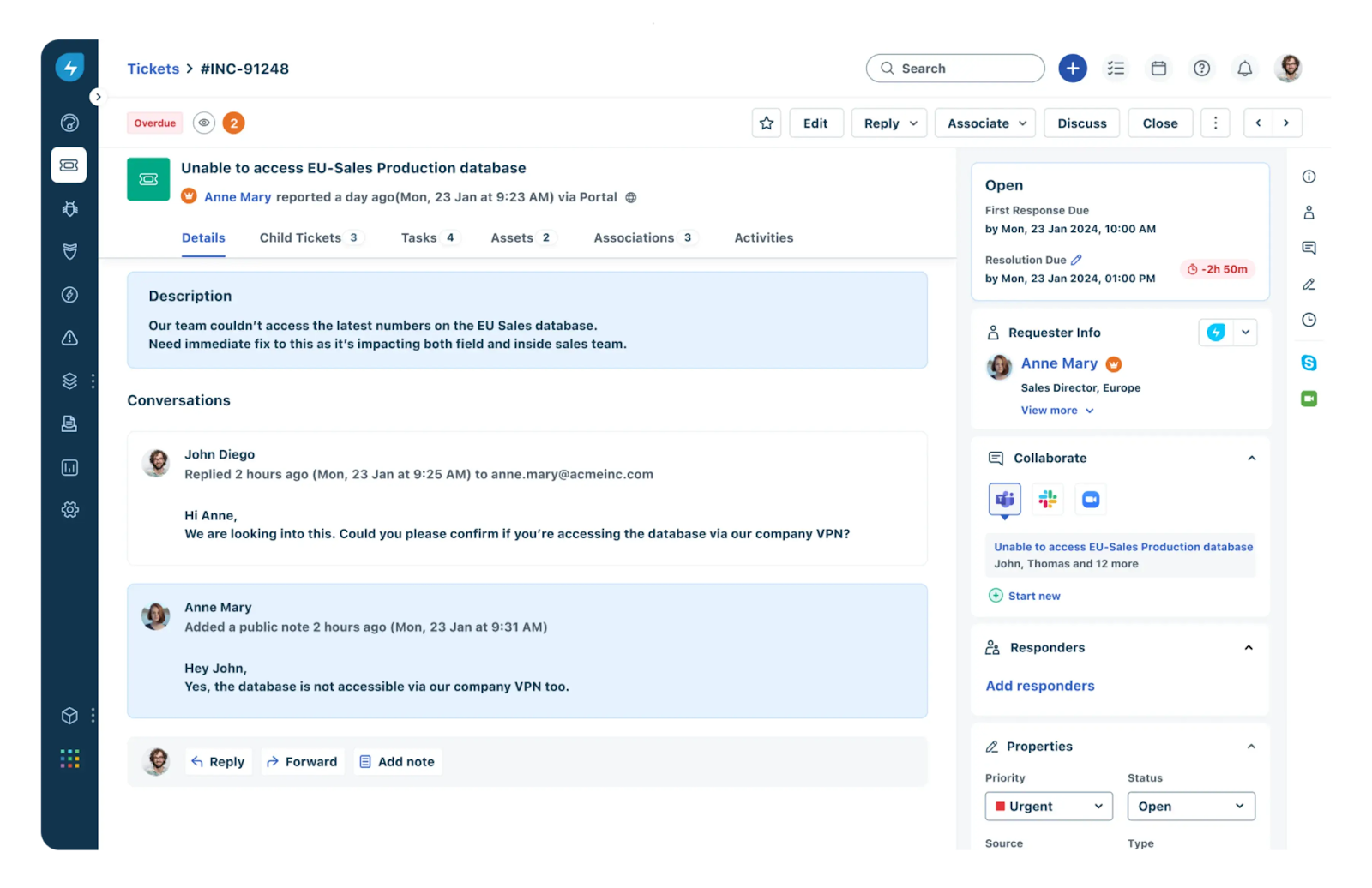
Freshservice’s standout feature for me is its automation capabilities that help you automate tasks like:
- Ticket assignments.
- Repetitive responses.
- Workflow management.
Pricing
Freshservice offers 4 paid plans with no free version, all of which have a free trial:
- Starter: $19/agent/month billed annually, or $29 billed monthly, which includes workspaces, incident management, and a self-service portal.
- Growth: $49/agent/month billed annually, or $59 billed monthly, which adds asset management, purchase order management, and business rules.
- Pro: $95/agent/month billed annually, or $115 billed monthly, which adds problem management, change management, and release management.
- Enterprise: $119/agent/month billed annually, or $145 billed monthly, which adds a sandbox, audit logs, and access to beta features.

Pros and Cons
✅ The tool’s interface is easy to set up and use daily.
✅ Advanced automation capabilities that are easy to set up.
✅ Native integrations with other Freshworks products and third-party tools.
❌ Fewer native integrations when compared to Freshservice alternatives.
❌ The customer support has been reported to be slow by verified users on G2, similar to ManageEngine.
#9: Startly
Best for: Small service teams that are looking for an inexpensive, unified ITSM + PSA stack with minimal integration overhead.
Similar to: SolarWinds, Ivanti.
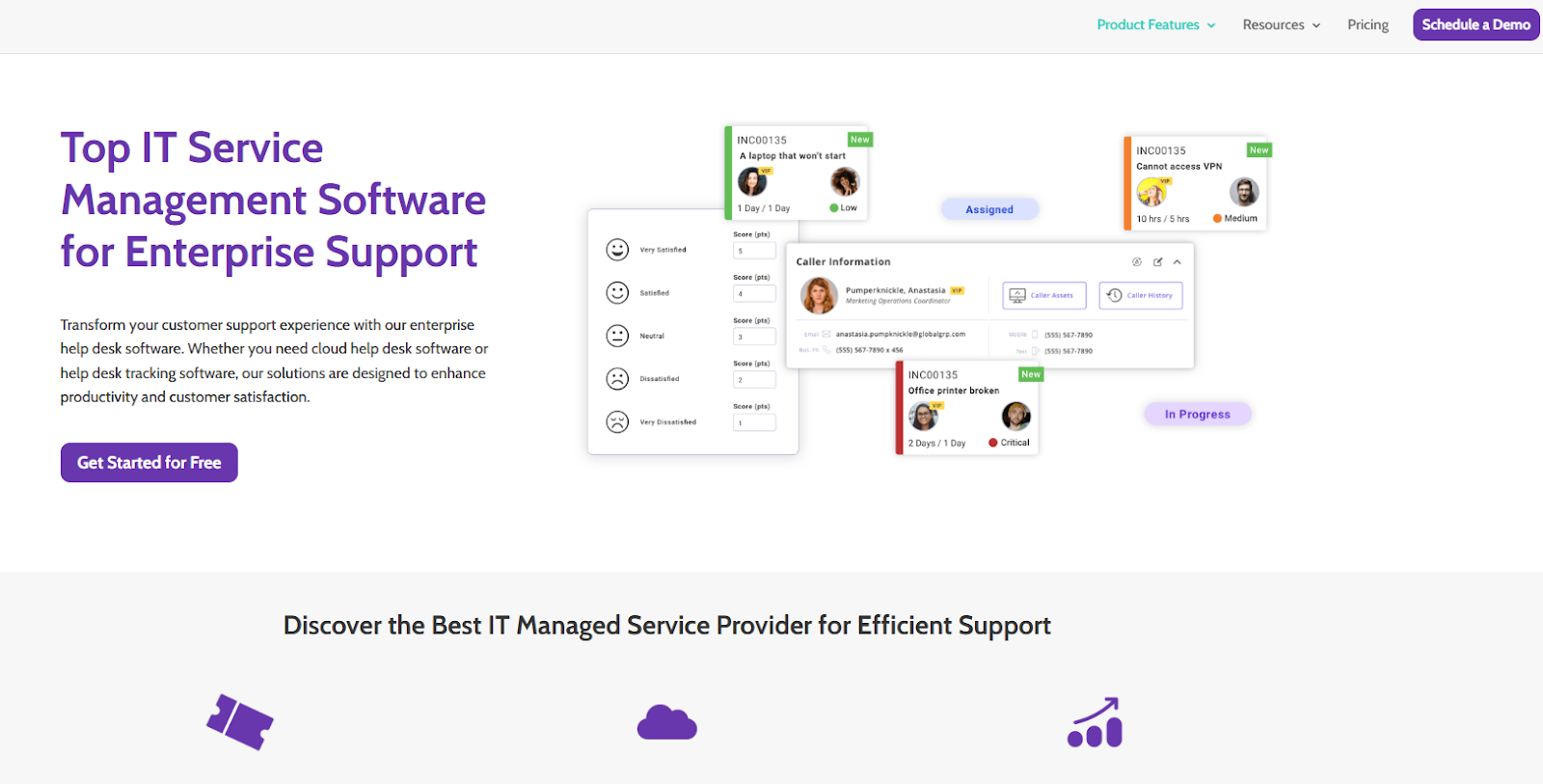
Startly is an all-in-one IT Service Management and Professional Services platform that targets service delivery organizations, offering ticketing, change, asset and project management in a single package.
It’s a viable ManageEngine alternative for teams that want integrated project and service operations without stitching multiple tools together.
Features
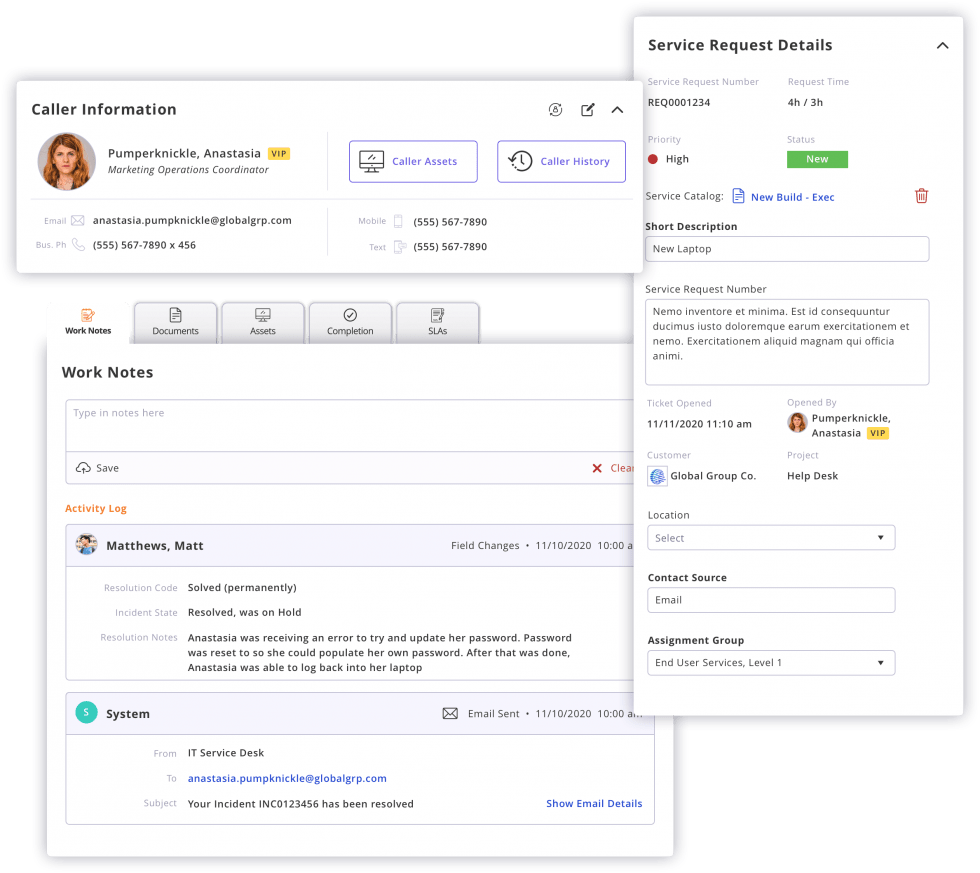
- Comprehensive ticketing system for tracking your organization’s incidents, service requests, and problems across multiple channels.
- Integrated billing + PSA tied to tickets and projects to close the loop from ticket > time > invoice.
- CMDB (Configuration Management Database) to manage asset relationships and prevent downtime.
- Built-in survey tool for collecting customer feedback without needing third-party software.
Standout Feature: Service Level Agreement (SLA) tracking and alerts
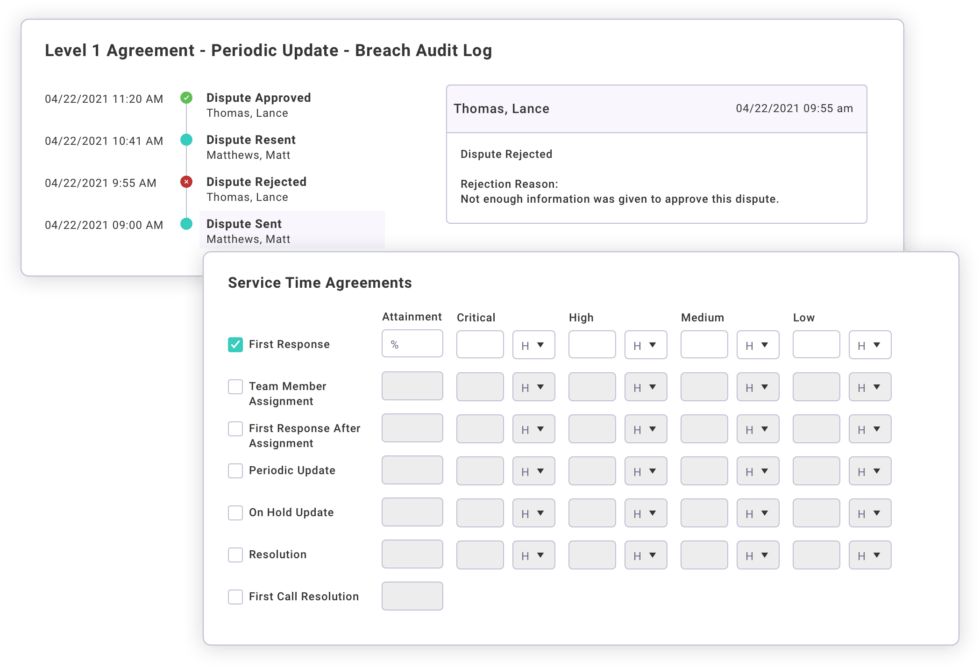
Startly lets you define, monitor, and enforce SLAs with real-time alerts to ensure timely responses and prevent breaches.
Pricing
Startly’s pricing structure is rather simple:
It costs $15/month/seat for all features with unlimited users, no annual contract requirement, and a 60-day free trial.
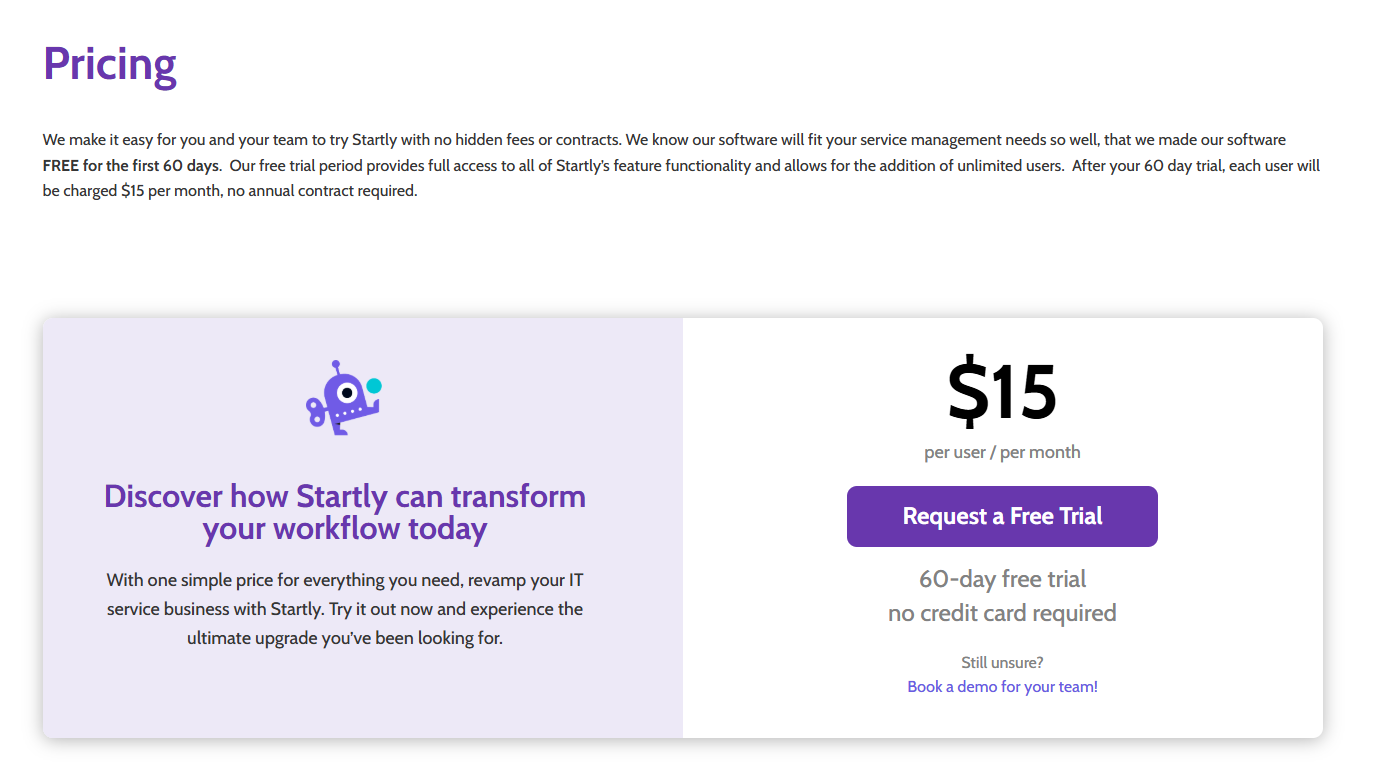
Pros & Cons
✅ The tool comes with a user-friendly interface, unlike some of the other tools on this list.
✅ You can integrate time tracking, finances, and ticketing into one system.
✅ Fixed $15/month/seat pricing for all features of the platform.
❌ Occasional bugs and errors.
❌ The tool offers limited reporting capabilities, which is why some people have been looking for Startly alternatives.
#10: Jira Service Management
Best for: Enterprises that need tight integration between IT service management and DevOps teams.
Similar to: Freshservice, Zendesk.
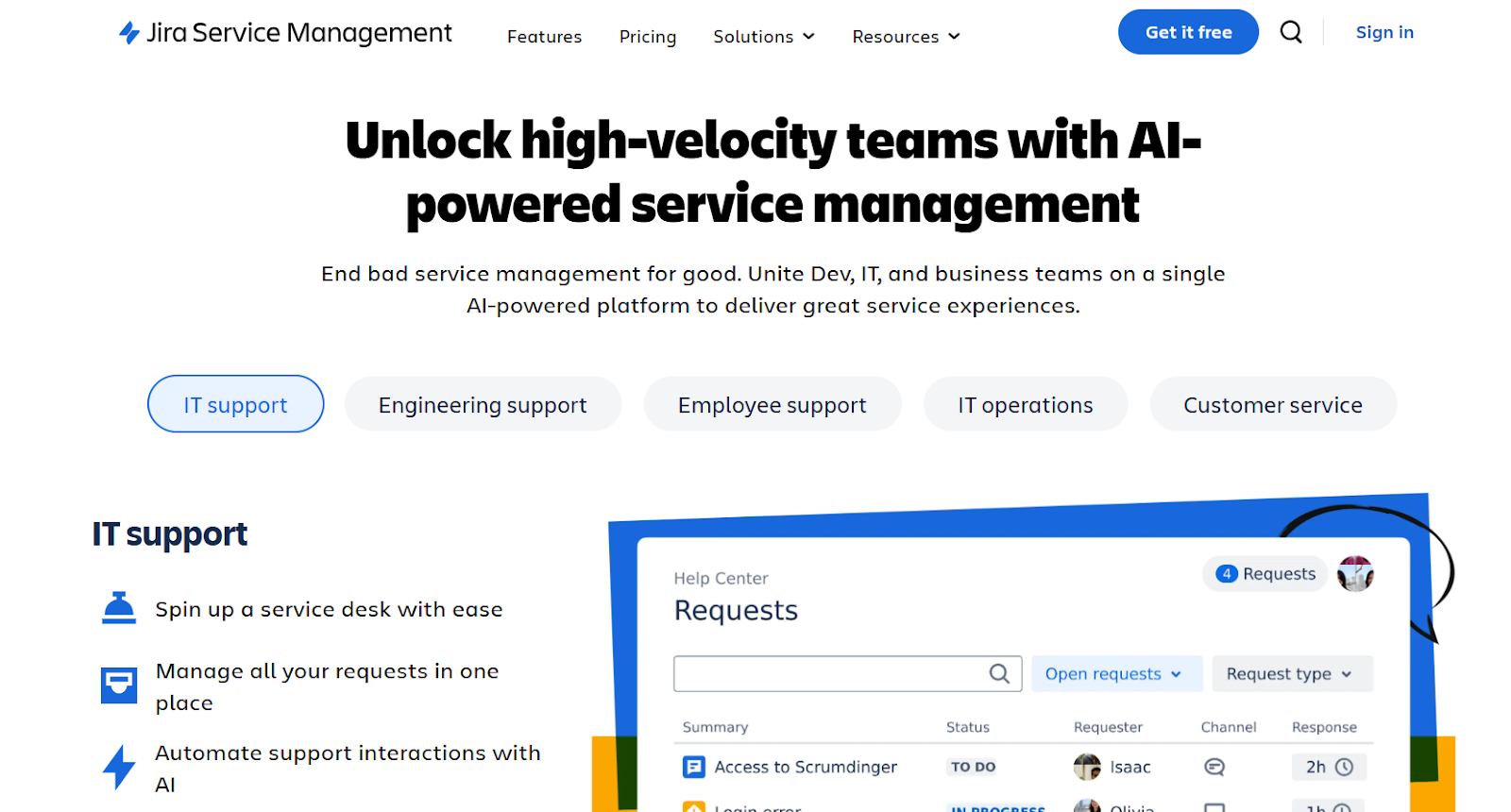
Jira Service Management offers developer-friendly ITSM with strong incident, change and problem workflows that tightly integrate with Jira software and DevOps pipelines.
The platform is an ideal alternative to ManageEngine for teams that want to combine service requests and incident response with developer triage.
Features

- Manage work across various channels, so that your employees and customers will receive the help they need quickly.
- Empowers development and IT operations teams to respond rapidly to incidents, resolve them, and continuously learn from them.
- DevOps-friendly change and incident workflows with automation and Confluence-backed knowledge to speed resolution and reduce change risk.
Standout Feature: Pre-Built ITSM Templates
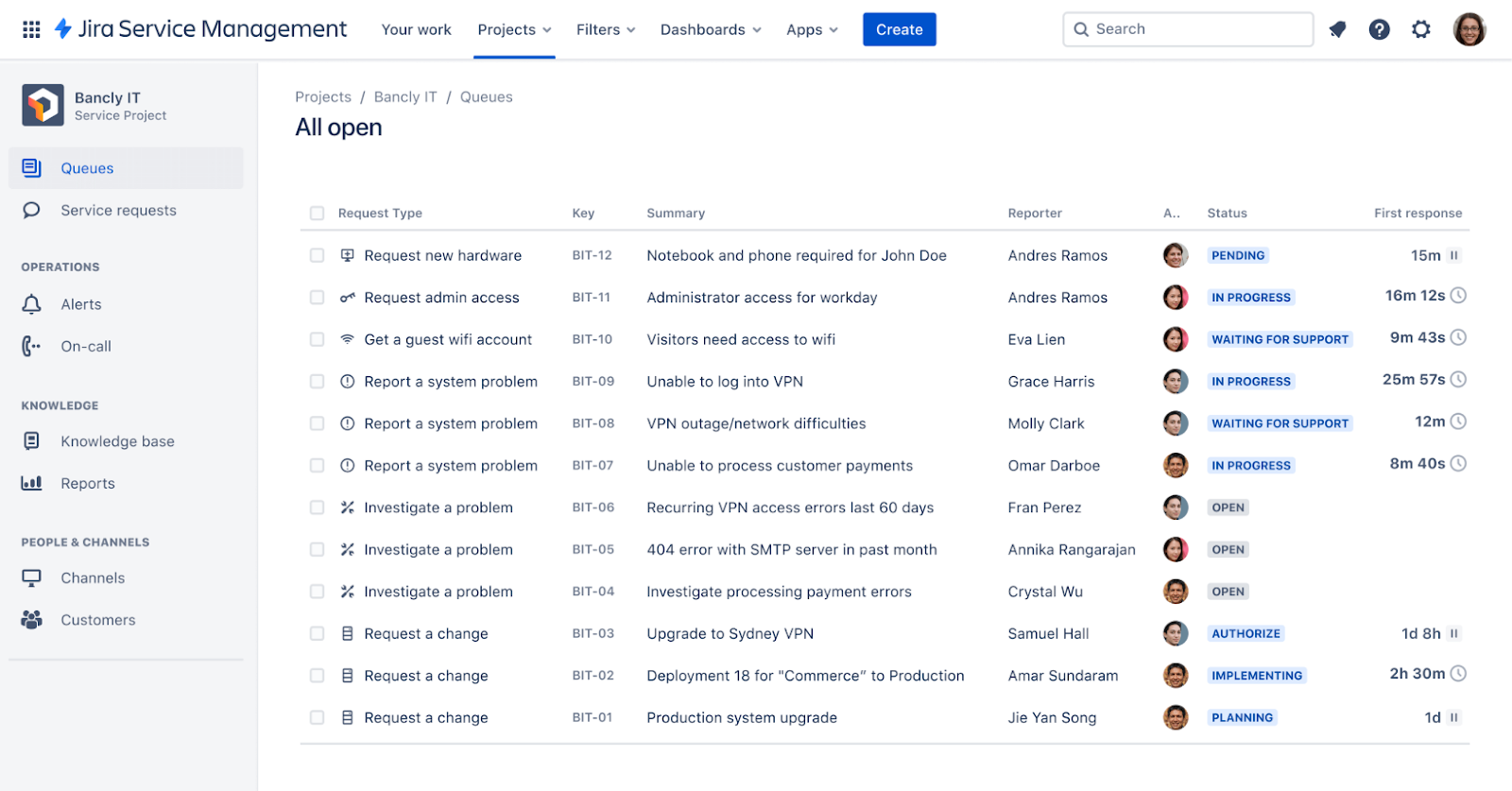
Jira Service Management helps IT teams get started quickly with pre-built, customizable ITSM templates.
Pricing
Jira Service Management offers four pricing plans for IT teams:
- Free: $0, for up to 3 agents, with access to basic features.
- Standard: $17.65 per agent/month, includes custom-branded help centre, alerts, on-call schedules, unlimited email notifications, and 9/5 support.
- Premium: $44.27 per agent/month, adds AI-powered services, virtual agent, asset and configuration management, advanced alert integrations, and 24/7 support.
- Enterprise: Custom pricing, adds advanced analytics, security, and unlimited automations, with up to 150 instances and 24/7 dedicated support.

Pros and Cons
✅ Excellent for integrating ITSM with software development and incident-to-change processes.
✅ Advanced automation capabilities to establish predefined workflows and triggers.
✅ Ready-to-use ITSM templates that you can start with.
❌ Dependence on plugins for certain features, which some users find inconvenient.
❌ Non-technical users might find Jira’s interface confusing at first, which is why some people have been looking for Jira SM alternatives.
Get Started With SmartSuite For Free & Set Up Your ITSM Workspace In Days
That was it from our detailed analysis of the 10 best ManageEngine alternatives on the market in 2025 for ITSM.
If you’re an IT leader looking to build IT service management workstreams, you can give SmartSuite a chance with our free plan and pre-built ITSM templates.
SmartSuite’s solution offers just the right customization, native collaboration capabilities and a library of 200+ project management templates to help teams create and maintain a project management workflow.
Here’s what's in it for your team when you try SmartSuite:
- Access to a free plan with features including multi-board views (Kanban, Chart, Map, Timeline, Card, and Calendar), 100 automations/month, and 40+ field types, including formula and linked record fields.
- No-code automation builder to set up to 500,000 trigger/action workflows.
- Built-in productivity tools, including time tracking, status tracking, and checklists.
- Team collaboration and planning tools such as whiteboards and SmartSuite docs.
- Resource management across projects and teams.
- 40+ field types, including the option to add your custom fields.
Sign up for a free plan to test the water or get a 14-day free trial to explore all its amazing features.
Or, if you’d like to talk to our team of experts, schedule a demo.
Read More
- ServiceNow Review: Is It Worth It?
- BMC Helix Pricing: Is It Worth It?
- 10 Best BMC Helix Alternatives For ITSM

Run your entire business on a single platform and stop paying for dozens of apps
- Manage Your Workflows on a Single Platform
- Empower Team Collaboration
- Trusted by 5,000+ Businesses Worldwide















